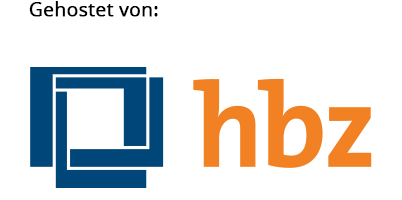Archiv
-
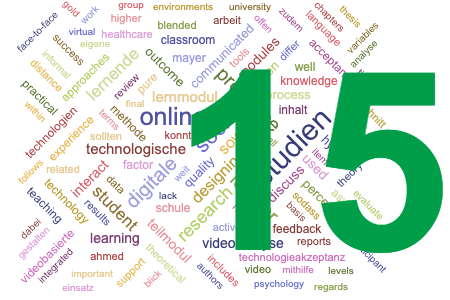
15. Issue December 2023
- Summary
- Effective design of digital learning offers is the basis for their acceptance and successful usage. This issue provides an insight into adult learners’ perceptions on e-Learning courses related to healthcare in Africa, the design of a video-based learning module to promote the professional recognition of relevant classroom management events, and a learning design that focuses on learning about Augmented Reality in computer science classrooms.
- Zusammenfassung
- Das effektive Design digitaler Lernangebote ist eine Voraussetzung für deren Akzeptanz und Nutzung. Diese Ausgabe gibt Einblick in die Wahrnehmung von e-learning Gesundheitskursen durch erwachsene Lerner in Afrika und präsentiert das Design eines videobasierten Lernmoduls zur Förderung professioneller Wahrnehmung von klassenführungsrelevanten Ereignissen im Unterricht sowie ein digitales Lerndesign für das Lernen über AR im Informatikunterricht.
Editorial
Effective design of digital learning offers is the basis for their acceptance and successful usage. This issue presents a scoping review that provides an overview of studies that integrate adult learners’ perceptions on e-Learning courses related to healthcare in Africa. Secondly, results of research into the design and acceptance of digital learning environments of two forms are provided: a video-based learning module to promote the professional reception of relevant classroom management events, and a learning design that focuses on learning about AR in computer science classrooms. To support effective design, a model for the participatory design of digital learning offers and a framework for investigating technology acceptance of immersive virtual environments are discussed. Empirical investigations toward understanding, modeling, and enhancing social presence in online distance learning environments are presented that aid the design of online learning environments. Finally, eight book descriptions provide an insight into newly published books in our area.
Lessons from e-Learning courses in healthcare in Afrikca
In their article “Lessons from e-Learning courses in healthcare“ Dana Gaigulo, Marika King and Juan Bornman used a scoping review to provide an overview of studies that integrate adult learners’ perceptions on e-Learning courses related to healthcare. They identified quality of structure, process, outcome and the influence of initial expectations on process and outcome quality as most influential. These should be taken into account when designing e-Learning courses for healthcare practitioners that integrate the adult learner’s perspective.
Design and acceptance of digital learning environments
Jennifer Janeczko, Robin Junker and Manfred Holodynski present in their article “Entwicklung eines digitalen, videobasierten Lernmoduls zur Förderung der professionellen Wahrnehmung von Klassenführung bei angehenden Lehrkräften“ the development of a digital, video-based learning module to promote the professional recognition of relevant classroom management events. Its usability was evaluated in terms of content, operability, and aesthetics. Their findings may support the construction of future video-based learning modules.
Josef Buchner and Marc Lachmann discuss in their project report “Die Entwicklung einer Augmented Reality Anwendung durch Lernende im Informatikunterricht: Didaktisches Design und Lessons Learned“ the development of a learning design that focuses on learning about AR in computer science classrooms. At its core is a project where students develop an AR application using the Vuforia Studio software, that visualizes safety instructions in the school's makerspace. Other teachers, who want to implement their own AR development projects, may use the learning design as a template.
Mathias Teine presents in his dissertation “Zur partizipativen Gestaltung von (digitalen) Lernangeboten in der betrieblichen (Weiter-)Bildung: eine empirische Modellentwicklung” a model for the participatory design of digital learning offers, which includes practical recommendations and accompanying materials that support the transfer of the underlying theory and findings into the practice of designing (continuing) vocational education.
Carolin Pletz examines in her dissertation „ Technologieakzeptanz von virtuellen Lern- und Arbeitsumgebungen“ how acceptance of immersive virtual reality environments used in work and learning can be assessed. Results indicate that the Technology Acceptance Model can be used, and further user-related, organisational and technology-specific factors influencing technology acceptance for the use of IVR in teaching-learning contexts are identified.
Joshua Weidlich characterizes in his dissertation „Presence at a distance: Empirical investigations toward understanding, modeling, and enhancing social presence in online distance learning environments” social presence as a complex psychological phenomenon that is multi-causally determined and nuanced in terms of its benefits for online distance learning.
Book Descriptions
„Digitale Medienwelt und Pädagogikunterricht“ is a new book by Alexander Martin, Stephan Wedding and Jörn Schützenmeister that describes how classes in education may be shaped to help pupils to recognize opportunities and risks of digital media in education.
Birgit Brandt, Leena Bröll and Henriette Dausend present in their book “Digitales Lernen in der Grundschule III“ the proceedings of the third Symposium of “learning digitally” at the TU Chemnitz.
Martin Weller’s new book „Metaphors of Ed Tech” uses metaphors as mental models to enable educators to move beyond pragmatic concerns into more imaginative and playful uses of technology.
Kylene M. Butler discusses Anwar Ahmed’s new book “Exploring Silences in the Field of Computer Assisted Language Learning”. According to her, this book emphasizes the potential and risk of computer assisted language learning in the classroom and addresses researchers, technology developers, educators and in-service teachers.
As editors of the book “Critical Digital Pedagogy in Higher Education”, Suzan Köseoğlu, George Veletsianos and Chris Rowell argue for a pedagogy of care in an online environment, instead of reducing learning to a transaction.
Jon Dron articulates in his book “How Education Works: Teaching, Technology, and Technique” a new theory that treats education as a technological phenomenon, encouraging anyone in an educational system to see what they do in a different and, hopefully, more productive and creative way.
In their new book “Principles of Blended Learning: Shared Metacognition and Communities of Inquiry“ Norman D. Vaughan et al. further explore and refine blended learning principles with an added focus on designing, facilitating, and directing collaborative blended learning environments by emphasizing the concept of shared metacognition.
Jörg Zumbach et al. present in their book “Digitale Medienbildung: Pädagogik – Didaktik – Fachdidaktik“ a collection of chapters highlighting the state of the art in media pedagogics and media didactics as well as providing recommendations for practitioners.
Joerg M. Haake
Editor-in-Chief, eleed -
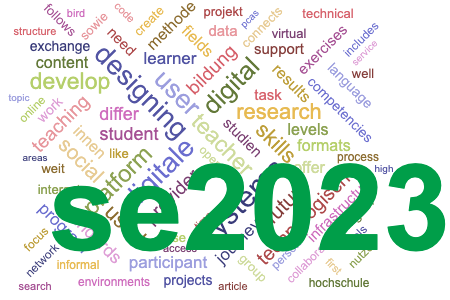
Sonderausgabe 2023
- Summary
- In the fall of 2023, the Go-live of the "Closed Beta" will provide the first glimpse of the (digital) networked infrastructure for education. At the same time, this special issue provides insight into the underlying concepts and contributions from the perspective of selected projects in the funding line.
- Zusammenfassung
- Im Herbst 2023 wird mit der Veröffentlichung der „Closed Beta“ erstmal ein Blick auf die digitale Vernetzungsinfrastruktur für die Bildung möglich. Diese Sonderausgabe eröffnet zeitgleich Einsicht in die dahinterstehenden Konzepte und Beiträge aus der Perspektive ausgewählter Projekte der Förderlinie.
Grußwort
Herzlich Willkommen zu unserer Sonderausgabe "Perspektiven von Wissenschaft und Praxis auf die digitale Vernetzungsinfrastruktur für die Bildung". Im Herbst 2023 wird mit der Veröffentlichung der "Closed Beta" erstmals ein Blick auf die digitale Vernetzungsinfrastruktur für die Bildung möglich. Diese Sonderausgabe eröffnet zeitgleich Einsicht in die dahinterstehenden Konzepte und Beiträge aus der Perspektive ausgewählter Projekte der Förderlinie. Dabei werden empirische Grundlagen beleuchtet, die Kompetenzen der Lernenden und Möglichkeiten der Kollaboration in den Blick genommen und wesentliche Aspekte wie Vernetzung und Internationalisierung thematisiert. Auch die Qualitätsentwicklung darf bei Artikeln zu diesem spannenden Großprojekt nicht fehlen. Wir wünschen Ihnen viel Vergnügen mit den Beiträgen.
Ulrike Lucke, Arno Wilhelm-Weidner, Alexander Knoth
Guest Editors, eleed
Die in den Beiträgen dieser Sonderausgabe beschriebenen Arbeiten wurden bzw. werden ganz oder teilweise vom Bundesministerium für Bildung und Forschung (BMBF) in der “Initiative Nationale Bildungsplattform” über folgende Projekte gefördert:
- BIRD (16NB001)
- AVILAB2 (16INB2005)
- CoHaP2 (16INB2009)
- EVA-NBP2 (16INB2022)
- FSJ2 (16INB2026)
- HPI4NBP (16INB2029)
- KoKoN2 (16INB2035)
- LernGrammis2 (16INB2040)
- PIM-2-02 (16INB2051)
- TOERN (16INB2061)
- TrainSpot2 (16INB2062)

Finanziert von der Europäischen Union – NextGenerationEU
Die geäußerten Ansichten und Meinungen sind ausschließlich die des Autors/der Autoren und spiegeln nicht unbedingt die Ansichten der Europäischen Union oder der Europäischen Kommission wieder. Weder die Europäische Union noch die Europäische Kommission können für sie verantwortlich gemacht werden. -
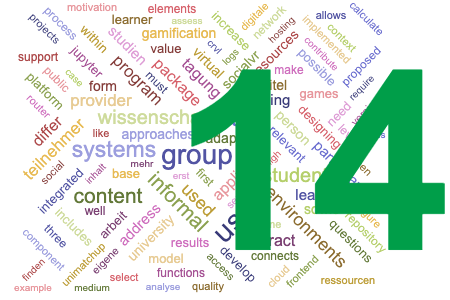
14. Issue August 2022
- Summary
- After the end of many COVID19 restrictions we see a shift back to presence teaching. Still, online and blended learning settings as well as online exams remain as educational institutions appreciate their value in times of crisis. This issue discusses the ongoing digital transformation regarding digitally enhanced forms of learning and scientific interaction, their infrastructures and support for academic help-seeking and group development.
- Zusammenfassung
- Nach dem Ende vieler COVID19-Beschränkungen nimmt die Präsenzlehre wieder einen größeren Raum ein. Trotzdem bleiben online und blended learning Settings und online Prüfungen wichtige Ergänzungen der Präsenzlehre. Diese Ausgabe diskutiert die fortschreitende digitale Transformation bezüglich digital-erweiterter Formen von Lernen und wissenschaftlicher Interaktion, ihrer Infrastrukturen sowie Unterstützung für akademische Hilfe und Gruppenbildung.
Editorial
After the end of many COVID19 implied restrictions we see a shift back to presence teaching. However, online and blended learning settings as well as online exams are not fading away as educational institutions learned to appreciate their value in times of crisis. The ongoing digital transformation in the educational sector affects digitally enhanced forms of learning and scientific interaction, such as the use of virtual reality, gamification and adaptive learning techniques, as well as infrastructures for digital learning and teaching and support for academic help-seeking and group development.
Digitally enhanced forms of scientific interaction and learning
Several contributions in this issue examine the use of virtual reality, gamification and adaptive learning techniques to support scientific interaction and learning.
Virtual reality and gamification
Raphael Zender and Miriam Mulders present in their article “Wissenschaftliche Konferenzen in Social Virtual Reality“ a case study on the use of social virtual reality for a scientific conference. They examine the suitability of the immersive medium as an educational technology for the conference setting, describe the conception and implementation of the conference with regard to the special characteristics of SocialVR, and present its strengths and weaknesses for academic conferences.
Annabell Brocker, Sven Judel and Ulrik Schroeder present in their project report “Integration of Gamification and Learning Analytics in Jupyter” an approach for supporting the learning of programming that integrates game elements and mechanics into Jupyter to increase motivation. Their approach enables the application of learning analytics and gamification analytics to monitor and evaluate measures and their impact.
David Baberowski et al. discuss in their project report “Inside the router” a first person virtual reality learning game designed to deepen procedural knowledge about IP-Routing and Network Address Translation. This approach supplements existing school learning settings regarding networks and shows how virtual reality can be combined with gaming to support acquisition of procedural knowledge.
In their project description “Die intoMINT-App” Korinna Bade et al. present an app that aims at encouraging girls grade 8 or higher to engage with science, technology, engineering and mathematics through entertaining activities and digital incentives. They show how motivation of the target group can be achieved through age and gender appropriate preparation of content and elements of gamification as well as through providing information on relevant job profiles.
Adaptive learning
Sebastian Linden and Michael Justus present in their project report “Hanser eCampus Mathematik“ an adaptive online mathematics course on differential and integral calculus, focusing on course structure, its didactic construction and its adaptivity. An interactive demo version let the reader experience the approach.
Mathias Bauer examines in his dissertation “Untersuchung des Einflusses von adaptivem E-Learning auf die Lernmotivation von Studierenden“ to what extent adaptive e-learning could foster learning motivation in self-regulated learning settings. While it could be shown that adaptive e-learning for the student-target group led to overall high levels of approval and acceptance and a consistently high learning motivation while learning with the different versions of the learning platform, a significant improvement of the learning motivation and user experience compared to the non-adaptive version of the platform could not be shown.
Infrastructures
In their article “Models for Content Management in a Next Generation Learning Management Ecosystem” Gerd Kortemeyer et al. propose either tool-interoperability or self-sovereignty as key technologies for establishing near-universal content repositories of shareable learning objects. Self-sovereignty technology seems especially relevant for constructing future open and data privacy respecting ubiquotuous learning infrastructures.
In his dissertation “Scalable and secure virtual laboratory for cybersecurity learning” Johannes Harungguan Sianipar combines the replacement of virtual machines by containers with providing additional resources by load sharing with the user on-premise machine or by employing cloud services. The result is an infrastructure for virtual laboratories that is practical and provides enhanced security.
Academic help-seeking and group development
Lisa Ollesch et al. present in their article “uniMatchUp!”: An application for promoting academic help-seeking and group development” the conception, development, and evaluation of a peer support web application for university students. They found that active engagement with the application led to increased student satisfaction. Cognitive group awareness information was considered more relevant than behavioral and emotional group awareness information about other students.
Digital transformation
In her book recension, Anne Martin discusses the book “Wissenschaftliches Arbeiten im Studium der Erziehungs- und Bildungswissenschaften” of Thorsten Bohl, which explains principles of scientific work to students of pedagocical and educational science.
The book “#Online-Lehre meets #Online-Coaching” by Thomas Hanstein and Andreas Ken Lanig introduces the concept of collegial coaching, which is based on the inductive approach to educational change processes. They present the concepts created through an interview study with teachers as an institutional training concept and as an integral part of both, continued teacher education and school development.
V. Frederking and R. Romeike present in their book “Fachliche Bildung in der digitalen Welt” an overview of research on discipline specific education in a digital world. They draw conclusions for discipline specific educational research in times of digitization, big data and artificial intelligence, and present a model for empirical research of discipline specific educational research in a digital world.
Joerg M. Haake
Editor-in-Chief, eleed -
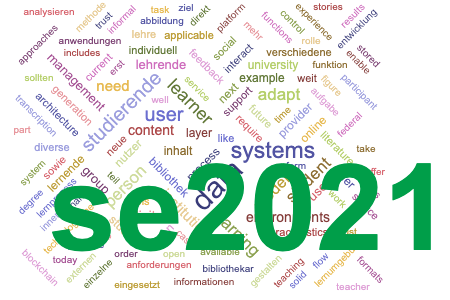
Sonderausgabe 2021
- Summary
- What would the Learning Management System of the future look like? In August 2020, 88 participants from Austria, Germany and Switzerland approached this question during a workshop on the “Next Generation LMS”. As you can see from this special issue, maybe there is no such thing, at least not in the sense of the traditional monolithic systems that we are using today.
- Zusammenfassung
- Wie sähe das Learning Management System der Zukunft aus? Im August 2020 gingen 88 Teilnehmer aus Österreich, Deutschland und der Schweiz dieser Frage im Rahmen eines Workshops zum Thema "Next Generation LMS” nach. Wie Sie aus dieser Ausgabe ersehen können, gibt es so etwas allerdings vielleicht gar nicht, zumindest nicht im Sinne der traditionellen monolithischen Systeme, die wir heute einsetzen.
Editorial
Carrying out a workshop during COVID-19 presented both challenges and opportunities: challenges, since like so many events in higher education, we had to completely rely on electronic collaboration tools (in this case Zoom and Miro), and opportunities, since we were already thinking “outside the box” – besides, it probably would have required a lot more logistics and advance notice to bring together such an illustrious crowd of e-learning specialists from three countries any other way. Some of their contributions are collected in this special issue of eleed.
Learning Management Systems have been around for three decades, but their basic design has not changed: they provide web-based tools for distributing content, making announcements, supporting discussions, grading, and assessments like homework and quizzes. In his contribution “Learning in 2040 – A journey to the future of tertiary learning,” Thomas Korner is discussing some of the emerging functionalities and trends which are not or only insufficiently supported by the current systems: study advisory BOTs, micro masters and nano degrees, ubiquitous individualized learning, learning groups, and the enabling blockchain technology.
The purpose of advisory BOTs, or AI-agents, would be the personalization of adaptive learning environments. The expected functionality and benefits of such systems are discussed in “Anforderungen an ein Next Generation LMS zur Unterstützung von Personalisierung aus bildungswissenschaftlicher Perspektive” by Claudia de Witt and Heike Karolyi, while the architectural foundations are described in detail in “From Diversity to adaptive Personalization: The Next Generation Learning Management System as Adaptive Learning Environment” by Niels Seidel, Jörg M. Haake, and Marc Burchart.
Micro masters and nano degrees (rather than comprehensive, monolithic degree programs) are oftentimes reflections of particular competencies. Learners may become increasingly self-directed in designing their own course of study and acquiring these competencies in social learning environments, which Elisabeth Kaliva and Susanne Glaeser explore in “Kompetenzorientiertes Lernen in der Post-LMS-Ära.”
Ubiquitous individualized learning can happen in local contexts, even outdoors, right there, right then. In their paper “Geobasiertes Learning Management am Beispiel MathCityMap,” Iwan Gurjanow, Annika Kanzinger, and Joerg Zender describe a smartphone-based, location-depending learning application. But “ubiquitous” can also mean “losing yourself” in the learning experience, anywhere, anytime, characterized by a phenomenon called “flow,” which Kerstin Steimle investigates in her paper “Flow-Erleben.”
Learning groups are about students teaching each other, and besides innovative methods for self-study, Marie Troike, Elise Schwarz, and Marcus Branke in their paper “'fair'NETzt lernen mit dem Inverted-Classroom-Konzept” describe the incorporation of social media and group work around peer-teaching videos into course modules.
As the last waypoint of the outlined “journey to the future,” blockchain technology is an essential ingredient in “A Model for Lifelong Learners' Educational Records and Identity in a Next Generation Learning Management System” by myself, Stefan Dröschler, Peter Riegler, and Nick Koslowski, where we propose a model for handling user data in the future.
None of this, however, would work without a repository of learning resources, and Martin Roos describes the role of the library in supporting learners in his paper “Mögliche Anforderungen an ein LMS aus Bibliothekssicht.”
The article “Initial Results of the Next Generation Learning Management System Workshop” by Stefan Dröschler and myself attempts to summarize at least some of the outcomes of this workshop, which we hope to be just the first one in a series. The main outcome, “the monolithic LMS is dead,” is picked up by Christian Wolters in his contribution “An den Systemgrenzen: die zukünftige Rolle von LMS in hochschulischer (Tele-)Präsenzlehre,” where he describes a modular “plug-and-play” platform for LMS functionality – this is likely the required kind of vehicle for the journey to the future.
The LMS is dead; long live the LMS! We hope that this special issue of eleed will inspire our readers to continue thinking “outside the box” into the next three decades with a distributed, modular, and adaptive learning management platform.
Gerd Kortemeyer
Guest Editor, eleed -
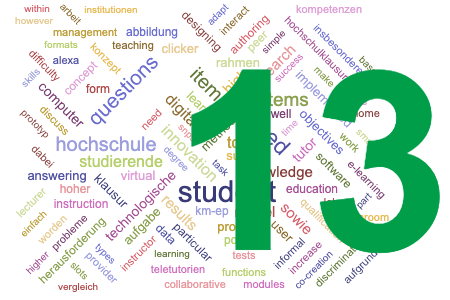
13. Issue November 2020
- Summary
- In times of restricted contact, educational institutions are forced to adopt digital means in order to compensate for loss of face-to-face teaching. Thus, e-learning is rapidly deployed everywhere. While crisis require fast response, it seems now necessary to transform the zoo of individual approaches into more coherent learning practices – at least on the granularity of study programs. Here, the experience of decades of research and practice on technology-supported learning may provide helpful insights for the transformation of educational institutions.
- Zusammenfassung
- COVID-19 zwingt Bildungseinrichtungen, Präsenzlehre durch digitale Mediennutzung zu ersetzen. Dies führt zu einem Zoo individueller Ansätze. Zur Realisierung kohärenter Bildungspraktiken sollten aktuelle Erfahrungen als auch Ergebnisse aus der Forschung und Praxis genutzt werden. Die Beiträge dieser Ausgabe zur Verbesserung digitaler Lehre auf Kursebene und zur digitalen Transformation von Bildungseinrichtungen geben hier interessante Einblicke.
Editorial
In times of restricted contact, educational institutions are forced to adopt digital means in order to compensate for loss of face-to-face teaching. Thus, e-learning is rapidly deployed everywhere. While crisis require fast response, it seems now necessary to transform the zoo of individual approaches into more coherent learning practices – at least on the granularity of study programs. Here, the experience of decades of research and practice on technology-supported learning may provide helpful insights for the transformation of educational institutions.
Improving learning on the course-level
On the course-level, contributions in this issue address different aspects of technology-supported learning, including assessment, augmentation of presence teaching, and the specific competence of systematic literature review.
Assessment
Menny Aka et al. present in their article “In-Class Formative Assessment in an Introductory Calculus Class” the results of a study of an audience response system in an introductory math course. The findings show benefits of this type of formative assessment for conceptual learning of students and for peer instruction.
Andreas Frey et al. discuss in their project report “Kompetenz¬orientierte individualisierte Hochschulklausuren und deren prüfungsrechtliche Einordnung” competence-based assessment of courses. They suggest a concept for the construction, administration and scoring of exams in higher education that can be used across universities and across disciplines, and may help to establish comparability of assessment results. Feasibility is discussed according to examination law and the general conditions for successful implementation in the regular operation of higher education institutions.
Augmenting presence teaching
Alexander Kiy, Dustin Wegner and Ulrike Lucke present in their article „Learning Smart in Home - Acceptance of an intelligent personal assistant as virtual tutor” a modular implementation of an Intelligent Personal Assistant using the wide-spread Amazon Echo as a realization of a virtual learning partner. Here, learning takes place at home, and not in the university. They discuss its evaluation according to the Technology Acceptance Model, and present scenarios how IPAs will be able to adapt the physical environment according to the learning goal. The presented concept does not rely on Amazon Echo but could also use an open-source component like Mycroft Mark II or Jasper to address data privacy concerns.
Frank Bensberg, Andreas Schmidt and Oliver Roll present in their project report „Teletutorien als Instrument zur Ergänzung der Präsenzlehre – Konzeption und Umsetzung für einen berufsbegleitenden Studiengang der Wirtschaftsinformatik“ the concept of teletutorials, which are an addition to classroom teaching, use web conferencing systems, and contribute to intensifying the quality of the relationship between university teachers and students. The case study describes planning, technical and organizational implementation of teletutorials as well as experiences.
Teaching systematic literature Review
Frank Bensberg, Gunnar Auth and Christian Czarnecki address the teaching of systematic literature review in their project report “Literaturanalyse mit Text Mining”. Here, they show the professional and technical design of a course familiarizing students with the potentials of text analytical methods and application systems (text mining, text analytics) and developing the digital competencies required for system-supported analysis and processing of literature data.
Digital transformation
On the institutional level, contributions in this issue focus on different aspects of digital transformation of educational institutions:
Christopher Prokes discusses in his recension the book “Teaching Naked: How Moving Technology Out of Your College Classroom Will Improve Student Learning” by José Antonio Bowen. Teaching naked argues for maximizing time in the classroom for face-to-face learning by removing technology from the classroom, to be considered a transformation quite opposite from what is often viewed as the future of learning in the digital age.
Tobina Brinker and Karin Ilg (Eds.) present the proceedings of the 5th Forum Hochschullehre und E-Learning-Konferenz in their book “Lehre und Digitalisierung: 5. Forum Hochschullehre und E-Learning-Konferenz”. Here, issues such as the didactical design of technology-supported teaching and learning scenarios in higher education institutions, and the competences of teachers and students required in digitally transformed education, are discussed.
Annika Jokiaho presents didactical scenarios for e-learning in higher education in her book „Didaktische E-Learning-Szenarien für die Hochschullehre“.
Birgit Eickelmann et al. (Eds.) present the results of the IEA-Studie ICILS 2018 (International Computer and Information Literacy Study) on computer- und information-related competences, incl. computational thinking, of 8th graders compared to other nations. The book “ICILS 2018 #Deutschland“ provides information necessary for development of schools, teaching and teacher development in the context of digital transformation.
Birgit Brandt, Leena Bröll and Henriette Dausend (Eds.) present the proceedings of the 2. interdisziplinäre fachdidaktische Symposium „Lernen digital“ (2019). In their book “Digitales Lernen in der Grundschule II: Aktuelle Trends in Forschung und Praxis“, insights from research and practice of didactics of different subjects in elementary school are presented.
Johann Pongratz develops an IT architecture for the digital university in his dissertation „IT-Architektur für die digitale Hochschule”. Based on the case study of TU Munich, Campus Management, IT strategy, IT governance, Digitization of teaching, IT security, privacy, IT support and future development are considered, and a future-oriented IT architecture for the digital Higher Education Institution is presented.
Benjamin Wallenborn presents in his dissertation “Entwicklung einer innovativen Autorenumgebung für die universitäre Fernlehre” an authoring environment for qualification-based courses and degree programs in the Moodle LMS, to be used in distance teaching. For this purpose, he develops the Qualification Based Learning Model, the Knowledge Management Ecosystem Portal, a competence manager, a competence profile manager, and course resp. degree program authoring tools.
Kevin Fuchs presents in his dissertation “Cognitive Spacetime” a method based on spatio-temporal data structures and algorithms that allow the implementation of artificially intelligent self-adapting systems. Such systems can be utilized for technology enhanced learning but also for other fields related to human-machine interaction.
Munir Salman addresses the problem of supporting knowledge, content and software asset integration in collaborative R&D and innovation processes. In his dissertation “Flexible Distributed R&D Data Management Supporting Social Network-Based Knowledge, Content, and Software Asset Integration Management in Collaborative and Co-Creative R&D and Innovation” he employs concepts from social networking and computer-supported cooperative work to facilitate flexible distributed R&D management in networked enterprises. While not closely related to e-learning this work may be considered relevant for developing networks of educational institutions aiming at co-creation of educational programs and content, thus transforming educational processes using digital technology.
This issue marks a transition in the editorial board of eleed. In 2018, Manfred Postel died unexpectedly. With Manfred, we miss a founding member of eleed’s editorial board, who helped to shape eleed and make it a success. Manfred was also responsible for project reports and licensing issues. In December 2019, Thomas Wenk joined the eleed editorial board and took over the editorship for project reports. We look forward to continue to improve eleed and to serve the community by distributing high quality open access information to researchers and practitioners interested in e-learning and education.
Joerg M. Haake
Editor-in-Chief, eleed -
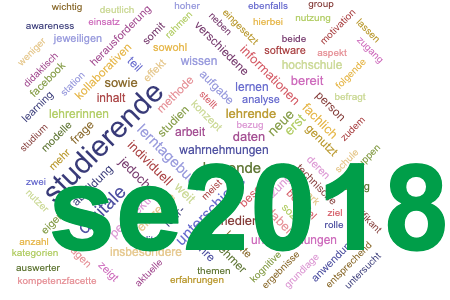
Sonderausgabe 2018
- Summary
- Digitally interlinked technologies reveal diverse opportunities in educational contexts but also present us with a new set of challenges, e.g., related to learning analytics or educational data mining. This special issue presents contributions from JFMH 2016 entitled "Measured education: opportunities and risks of digitally interlinked technologies", focusing on critical and interdisciplinary examination of opportunities and risks.
- Zusammenfassung
- Digital vernetzte Technologien bieten in Bildungskontexten verschiedene Möglichkeiten, stellen aber auch neue Herausforderungen, z.B. bezüglich Learning Analytics oder Educational Data Mining. In dieser Sonderausgabe präsentieren wir dazu ausgewählte Beiträge des 5. Junges Forum für Medien und Hochschulentwicklung zum Thema "Die vermessen(d)e Bildung: Möglichkeiten und Risiken digital vernetzter Technologien".
The measured education: opportunities and risks of digitally interlinked technologies.
Proceedings of the fifth JFMH (Junges Forum für Medien und Hochschulentwicklung) 2016About the JFMH
This issue presents extended versions of selected contributions to the JFMH 2016. The JFMH is an interdisciplinary forum for young researchers and young professionals in the areas of media education, media didactics, and technology-enhanced learning at different learning places like universities, primary schools, or further training. The forum series is under the patronage of the German Society for Media in Science (GMW), the German Association for Educational and Academic Staff Development in Higher Education (dghd), the Section Media Education of the German Educational Research Association (DGfE), and the Special Interest Group "E-Learning" of the German Informatics Society (GI) since 2012. The fifth JFMH took place on the 10th and 11th of June 2016 in Darmstadt and was jointly organized by different groups at the Technische Universität Darmstadt.
The theme and the keynotes
The theme of JFMH 2016 was The measured education: opportunities and risks of digitally interlinked technologies (Die vermessen(d)e Bildung: Möglichkeiten und Risiken digital vernetzter Technologien). Digitally interlinked technologies reveal diverse opportunities in educational contexts but also present us with a new set of challenges, e.g., related to learning analytics or educational data mining. The objective of the JFMH 2016 was to critically examine opportunities and risks on an interdisciplinary basis. Different perspectives of researchers and professionals came together. This was reflected in different contributions of the young participants as well as in the following keynotes.
- Thomas Damberger discussed the "quantified self" movement from the perspective of education theory. The recording of his keynote is available at http://bit.ly/2lFm2ZL.
- Ilona Buchem took a critical look at open badges to appreciate and present competencies individually acquired at university courses. The recording of her keynote is available at http://bit.ly/2qbeL9I.
- Alexander Kiy took a more technical stance on the theme by presenting a diversity of data sources, ranging from centralized learning systems like LMS through apps, to sensors from personal devices like smart watches. He also presented different examples to support the introductory study phase developed at the University of Potsdam. The recording of his keynote is available at http://bit.ly/2qbZVzP.
- Josef Wiemeyer brought attention to a different perspective – the measurement of the quality of different learning resources and teaching approaches – by presenting results from his manifold field studies performed during his academic teaching. The recording of his keynote is available at http://bit.ly/2EC0PZy.
Contributions in this issue
Josef Wiemeyer mentions in his contribution the analysis of data generated by the usage of digital media during the learning process. This analysis allows information to be revealed concerning learning behavior and the quality of the media and the teaching process. Wiemeyer compares the self-improvement benefits of the increase of knowledge with the price that has to be paid for, in particular, the increased effort concerning staff, material, and time. He illustrates this using four different examples from teaching sport science.
Alexander Kiy presents an explanatory framework for the media-didactical design of teaching, learning, and research scenarios. The starting point for his considerations is the wide range of available digitized teaching and learning support, which is hardly manageable for teachers. He uses a variety of practices modelled in the framework as a starting point to outline a concept of a system architecture. This enables on the one hand the automatic provisioning of any desired application, and on the other hand the cross-system aggregation of user data.
Anne Mock und Daniel Bodemer are dealing with open learning settings in which exchange partners in social media platforms, who are not part of the learning group, contribute with further knowledge. She presents a study that examines whether there are differences in the perception of cognitive and social awareness information, as well as the strength of the exchange partners’ interrelations. Hence, she derives and tests an awareness taxonomy for formal learning settings.
Sophie Schaper examines the use of the social networking site Facebook and the messenger WhatsApp with regard to student-teacher relationships. She performed problem-centered interviews with students and interpreted them by a qualitative content analysis. Results show that students differ in their interaction with their teachers. Two types of students can be distinguished based on criteria from four different categories, which have been identified by means of the qualitative analysis.
Armin Egetenmeier’s contribution belongs to the area of predictive learning analytics for student success – a widespread application of learning analytics. In his contribution he shows that with the help of a comprehensive database study, dropouts at the Aalen University of Applied Sciences can be precisely predicted. He presents different statistical methods for the prediction of dropouts based on data sets consisting of measures collected in a pre-study course in math combined with administrative data sets of the university information system.
Kai Gebhardt presents a concept and tool to analyze the learning progress of students based on exercises they work on at different self-training stations during an exercise session. At the different stations, different tasks are processed by the students and different competencies are to be conveyed. Based on each students’ responses at the stations, a competence level achieved in the conveyed competencies is calculated. These levels are presented to the students and the teacher. Thereby, the teacher gets an overview of the competencies of the students and is able to identify areas which he should address in depth with the whole group.
Erik Kremser and Yanick Ballensiefen present their comprehensive experiences in the use of collaborative learning journals in a university course and they also present evaluation results. In the collaborative learning journal, the students merge feelings and thoughts about the learning content in addition to filling out an individual part that is used to reflect their findings and own development. In the paper, the authors compare two concepts based on the two different software tools Mahara and OneNote.
Lisa Scharrer, Michael Bender, and Andrea Rapp argue the use of methods and techniques from the field of digital humanities in teaching scenarios in primary school and university education. To transfer the concepts of digital humanities didactically appropriately into digital teaching scenarios, an intensive reflection of the processes and frameworks is required. In the paper the authors present these aspects by discussing two examples, co-occurrence visualization and part-of-speech tagging, in detail.
Linda Heise investigates the inclusion of active top athletes who study in parallel to their competitive sport. The paper presents results of a qualitative study about the challenges and special needs of this group of students. Furthermore, it discusses different dual-career-allowing perspectives of digital learning.
Quantified tweets: measurements of the digital participation at the forum
It is a long tradition at the JFMH series to tweet about the JFMH during the forum using the hashtag #jfmh and the according year, which this time was #jfmh16. This kind of communication is used to partially document and reflect on the presentations and discussions, to forward links to related sources, and to partially allow participation for community members who are absent. Franco Rau analyzed the digital participation at the forum based on the tweet statistics. The archive analyzed contains 356 tweets, 188 links, and 142 retweets from the period of June 6th to June 12th, 2016.
The following figure shows the temporal distribution of the tweets during the two forum days. It shows a strong peak at the morning of the 2nd day corresponding to the keynote held by Ilona Buchem.

Figure 1: Twitter activity during the JFMH
The data also allows evaluations of the relationships between the different authors of tweets. The following figure shows the replies (solid grey), mentions (dashed grey dotted), and retweets (dashed blue). Overall the high degree of interaction becomes obvious.

Figure 2: Relationships based on #jfmh16 tweets
Acknowledgments
In concluding, we would like to thank all those who have contributed to the JFMH 2016 as well as to this eleed issue, without whose support both the forum and the issue would neither would have been possible. The representatives of all four societies involved in the JFMH should be mentioned. They worked together with the local organizers to design the structure and the program of the forum. Members of all these societies assisted the young participants and authors. They gave manifold feedback in the preparation of their presentations as well as their papers.
Our thank also goes to the keynote speakers for their important ideas, to the participants of the forum for their passionate discussions, and to the authors of the papers presented in this issue for their patience in connection with the publication process.
A special thanks goes to the financial supporters of the JFMH, namely the Forum for Interdisciplinary Research (FIF) and the Profile Area Internet and Digitization, both at Technische Universität Darmstadt, as well as to the two editors, Franco Rau and Christoph Rensing, who also managed all the important matters at Darmstadt and provided a welcoming, immensely fruitful atmosphere and a great space for networking.
Finally, we would like to thank the eleed journal and their publishers for the opportunity to release the JFMH contributions in this issue.
The editors
Franco Rau, Christoph Rensing, Diana Bücker, Valentin Dander, Andrea Gumpert, Anja Lorenz, Johannes Konert, Angelika Thielsch, and Timo van Treeck
-
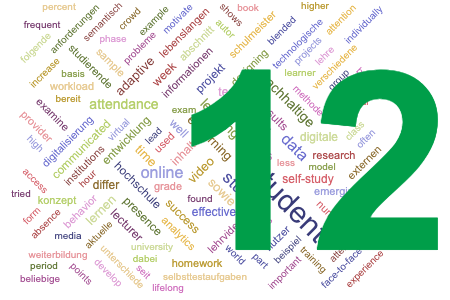
12. Issue June 2017
- Summary
- Initially, e-learning has been seen as a means to replace face-to-face teaching by digital media in order to increase learning success at lower cost. Meanwhile, blended learning environments seem a more promising approach. Issue 12 presents contributions to four hot topics in the e-learning domain: blended learning, new technological approaches for e-learning, learning analytics, and new demands on educational programs.
- Zusammenfassung
- Anfänglich sollte e-learning Präsenzlehre durch Lehren mit digitalen Medien ersetzen, um den Lernerfolg bei geringeren Kosten zu erhöhen. Inzwischen scheinen blendend-learning Umgebungen ein erfolgsversprechenderer Ansatz darzustellen. Die Ausgabe präsentiert interessante Beiträge zu vier aktuellen Themen im Gebiet des e-learning: Blendend Learning, neue technologische Ansätze für e-Learning, Learning Analytics und neue Ansprüche an Studiengänge.
Editorial
Initially, e-learning has been seen as a means to replace face-to-face teaching by digital media and new technologies in order to increase learning success at lower cost. In the meantime, blended learning environments seem to be a more promising approach.
This issue presents interesting contributions to four hot topics in the e-learning domain: blended learning, new technological approaches for e-learning, learning analytics and new demands on educational programs.
Blended Learning
Rolf Schulmeister examines in his article “Presence and Self-Study in Blended Learning” why comparisons show online courses to be inferior to blended learning courses. He shows that the face-to-face component of blended learning environments has a positive effect on learning success, exceeding the impact of self-study. In conclusion, Schulmeister rejects the increase of teaching with media at the expense of presence.
Julia Lutz describes in her project report “Blended Learning in der Musiklehrerbildung. Erfahrungen und Perspektiven am Beispiel eines Praxisprojekts“ first results of the evaluation of an approach, which links online e-learning offers with classroom sessions to support teams of students and school teachers in planning, implementing and evaluating a teaching unit. Early results emphasize the importance of networking and remote collaboration between training phases.
Daniel Sitzmann introduces in his dissertation “Rahmenwerk für zielgruppenorientiertes Blended E-Learning im MINT-Bereich im Kontext des Lebenslangen Lernens“ a framework for target group-oriented blended e-learning in STEM disciplines in the context of Lifelong Learning. It addresses the requirements for such an e-learning application in the STEM sector for diverse target groups as well as functional requirements of the STEM sector and from lifelong learning.
Gerhard Stitz examines in his dissertation “Multiplikatorische Fortbildungen mit E-Learning-Unterstützung“ how multiplier training can be supported by e-learning. To this end, the thesis presents a blended learning concept for multiplier training, a process model, and a semantic map of relevant e-learning tools.
New technological approaches for e-learning
Ingolf Waßmann, Martin Müller and Djamshid Tavangarian introduce in their article “J-Quizmaker” a web application that helps to turn video segments into resources that can be enriched by self-test tasks with defined follow-up activities. The result supports semantic processing of video material in two ways: it enables adaptive learning by providing video content based on learner performance and knowledge as indicated by the self-tests and it makes information about semantic content of video segments available for further search and linking activities.
Begoña Gros, Kinshuk and Marcelo Maina (eds.) explore in the book “The Future of Ubiquitous Learning” emerging pedagogical perspectives based on the design of new learning spaces supported by digital technologies. Its collection of research covers foundations of emerging pedagogies, learning designs for emerging pedagogies and adaptive and personalized learning.
Anke Hanft et al. present in their book „ Organisation und Management von Weiterbildung und Lebenslangem Lernen an Hochschulen“ results of the scientific evaluation of the project „Organisation und Management der Universität Oldenburg“. Approaches for planning, development and organisational integration of continued education offers in a university are presented and analysed. Case studies examine challenges of sustainable implementation of continued education and lifelong learning at universities.
Based on empirical studies and literature analysis, Nina Kahnwald et al. describe in their book “Informelles Lernen Studierender mit Social Software unterstützen“ how universities may support student learning by social software.
Sue Gregory et al. (eds.) present in their book “Learning in Virtual Worlds: Research and Applications” an outline of the emerging trends and developments in the use of 3D virtual worlds for teaching and learning, including learner interaction with virtual worlds, communication modes and perceived presence, accessibility issues for elderly or disabled learners, enhancement of learner immersion, and best practices in the design and implementation of virtual world-based learning interventions.
George Veletsianos (ed.) provides in the book “Emergence and Innovation in Digital Learning: Foundations and Applications” a one-stop locale for work on emerging technologies and practices in online education. It is the intention to enable researchers and practitioners to conceptualize, critique, and enhance their understanding of the foundations and applications of new technologies.
Learning Analytics
In his article “The Spectrum of Learning Analytics” Gerd Kortemeyer provides a survey on two decades of research on learning analytics. He distinguishes two main perspectives as extremes of a spectrum: the transactional perspective focusing on improving learning success within a course and the institutional perspective focusing on improving success in a degree program. Finally, he identifies a combination of both extremes as a promising open issue.
New demands on educational programs
Frank Bensberg, Kai-Michael Griese and Andreas Schmidt describe in their project report “Digitalisierung der Arbeit vor dem Hintergrund der nachhaltigen Entwicklung“ an exploratory job advertisement analysis aiming at determining the relevance of concepts of sustainability and digitization in the labor market, and identifying which job profiles are in demand in this context. Results may inform players in the educational sector about coming demands impacting their programs.
Joerg M. Haake
Editor-in-Chief, eleed -
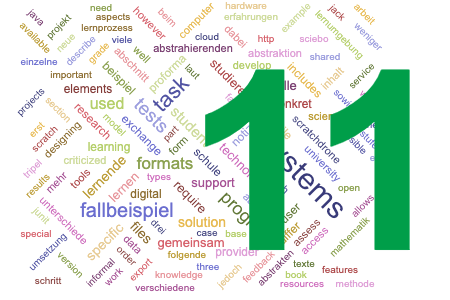
11. Issue November 2015
- Summary
- E-learning is supposed to support teaching and learning through dedicated technology and didactics. For the design of successful e-learning, the interplay of e-learning technology, didactics and the domain of learning are of crucial importance. Issue 11 presents new insights in implementing e-learning in a dedicated domain, didactical support for learning by abstraction, and e-learning infrastructures.
- Zusammenfassung
- E-learning soll Lehren und Lernen durch spezielle Technologie und Didaktik unterstützen. Für erfolgreiches e-learning ist das Zusammenspiel von Technologie, Didaktik und Lerngegenstand essenziell. In dieser Ausgabe werden neue Ergebnisse zur Implementierung von e-learning in speziellen Domänen, zur didaktischen Unterstützung von Abstrahierendem Lernen, und zur e-learning Infrastruktur präsentiert.
Editorial
E-learning is supposed to support teaching and learning through dedicated technology and didactics. Consequently, the interplay of e-learning technology, didactics and the domain of learning are of crucial importance for the design of successful e-facilitated learning. Thus, this issue presents new insights in three related areas: implementing e-learning in a dedicated domain (in this issue, programming and mathematics), new didactical support for learning by abstraction, and e-learning infrastructures.
Implementing e-learning for learning programming or mathematics
Learning programming requires solving programing tasks, which are tedious to develop. Reusability of programming tasks could contribute to lower cost and to increase quality. Therefore, Sven Strickroth et al. present in their article “Erfahrbares Programmieren durch den zielgerichteten Einsatz von Flugdrohnen im Informatikunterricht” an exchange format supporting export and import of programming tasks.
Furthermore, learning programming requires high motivation from the learner to master difficulties (e.g., while solving programming tasks), to collect experiences, and to develop programming competency. For this purpose, Raphael Zender et al. propose in their article “ProFormA: An XML-based exchange format for programming tasks” an approach for experience-based programming, which combines multi-layer abstraction in a scripting platform with a fascinating domain (i.e., flying a drone). Experiences show that this approach leads to a high motivation of young learners.
For the math domain, Stephan Claus et al. present in their project report “Mathe-Üben in Studium und Abitur” an app supporting training of high school math as required by junior students of a university. Experiences show that such an app can foster activation and self-regulated learning for novice students.
Didactical support for learning by abstraction
The article “Abstrahierendes Lernen durch aktive Modellbildung” of Schümmer et al. presents an approach for supporting learning by abstraction from analyzing examples and constructing an abstract general model representing the underlying principles. The proposed learning process and corresponding learning environment has been shown to support learning by abstraction of theology students. The evaluation also shows that learners reflect on their learning process and adapt the process to their preferences.
e-learning infrastructures
Raimund Vogel et al. present in their project report “Building an Academic Cloud for 500,000 Users” the aims and technological as well as legal solution of building the sciebo academic cloud for 500.000 students and researchers in North Rhine-Westphalia.
Three books are presented, which investigate open access to formal and informal learning (G. Sampson et al.), present new trends in, among other domains, e-learning (Khaled Elleithy & Tarek Sobh), and discuss theory and implementation of e-learning systems, environments, and approaches (Pedro Isaias et al.).
Three new dissertations are presented, which deal with a fast platform for interactive e-learning systems (Ondrej Havel), a pattern-based approach to mobile games (Birgit Schmitz), and the use of social software portfolios (Marcel Kirchner).
Finally, Lisa Marie Blaschke and Olaf Zawacki-Richter report about Otto Richter’s latest book “Against the tide: Critics of Digitalization”, which discusses some of the most notable critics on political hazards of digitalization.
Joerg M. Haake
Editor-in-Chief, eleed -
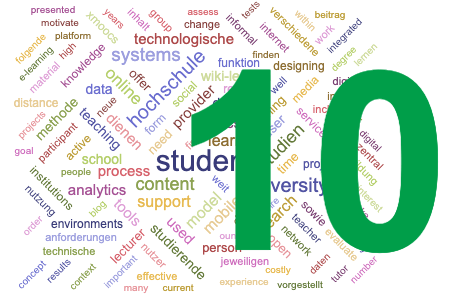
10. Issue December 2014
- Summary
- The 10th issue examines e-learning and education from four perspectives: Two articles examine lessons learnt from blended and online courses and from a blog-based distributed seminar. Three articles analyze the impact of environmental change on e-learning #organization. Two articles focus on technology use for creating e-learning platforms. Finally, a roadmap for learning analytics research is presented.
- Zusammenfassung
- Ausgabe 10 betrachtet e-learning und Bildung aus vier Perspektiven: Zwei Beiträge berichten Erfahrungen aus blended und online Kursen bzw. einem Blog-basierten Seminar. Drei Beiträge analysieren Auswirkungen einer sich verändernden Umwelt auf die e-learning Organisation. Zwei Beiträge betrachten den Technologieeinsatz zur Plattform-Entwicklung. Zuletzt wird eine Roadmap für die Learning Analytics-Forschung präsentiert.
Editorial
In 2004 eleed was launched as part of an open access initiative funded by the state of North Rhine-Westphalia, Germany, and its first issue was published in February of 2005. The current issue no. 10 marks eleed’s 10th anniversary. From the very beginning, eleed is supported by the state-funded HBZ running its publication infrastructure and – after eleed’s initial state funding ended – by the FernUniversität in Hagen supporting its editorial staff and software development.
eleed publishes a mix of current research results, experience and practice reports on e-learning and education, and community information on e-learning dissertations, new e-learning books, tools, and projects. The focus is typically on works that combine technology and education and provide insight into how effective e-learning scenarios can be implemented. Readership is continuously rising. More than 6.000 monthly readers from all over the world is an impressive number, given the relatively small number of people involved in e-learning research and development. This proves that an open access journal, given the necessary support from public sources, can successfully provide a platform for open communication of research and practice knowledge! The editorial board expresses its gratitude to all supporters, who made this development possible.
To improve its communication and information function, eleed launched a new and enhanced web presence in May 2014. New services include improved search and exploration of meta-data and relationships between articles (see the “context of this contribution” section within an article). To further aid its readership, in 2015 new services will be deployed. They will facilitate readers in exploring eleed content, saving exploration results, and re-executing complex searches, both, individually and collaboratively. Thus, eleed will gradually evolve from a publication venue into a collaboration space for readers and authors sharing e-learning related interests.
With the shift from isolated learning platforms and scenarios to more open, learner-centered and adaptive learning scenarios and systems, the challenges of finding and combining appropriate learning objects and services into a usable learning environment become increasingly important, especially as changing societal expectations and new technologies emerge. Consequently, the articles in this anniversary issue approach e-learning and education from different perspectives:
Lessons-learnt perspective
Gerd Kortemeyer presents experiences from 20 years of blended and online courses in his article “Over two decades of blended and online physics courses at Michigan State University”. He found that some online-only courses led to better exam results than traditional on-campus lectures. This was especially true for courses with assessment embedded into the online material. He reasons that this may be due to not taking advantage of face-to-face presence in respective traditional lectures.
In their article “Advertising Psychology – The Blog Seminar”, Björn Badura, Joseph Greve, and Annette Kluge focus on a specific didactical seminar setting. They present the didactical design and experiences with three iterations of a blog-based distributed seminar. They show that learners subjectively assessed positively aspects such as enjoyment, usefulness and difficulty as well as learning success and attitude towards the seminar.
The book description of Luka Peters‘ “Methodik für Wirtschaftswissenschaftler” presents an overview of didactical methods applicable to electronic media.
Organizational perspective
Three articles analyze the impact of a changing environment (i.e., governmental expectations, education for free, new ICT technology) on the organization of e-learning. Rob Koper presents an analysis of changing demands and their impact on the learning organization of a distance teaching university. Taking the example of the OUNL, his article “Towards a more effective model for distance education” shows the change process and resulting redesign of the educational model used by the OUNL, which is being changed from traditional guided self-study to active online learning.
Rolf Schulmeister analyzes the development of “The Position of xMOOCs in educational systems” and highlights the changing aim (from providing free education for the masses to fee-based continued education), problems and possible solutions for fitting xMOOCs into teaching organizations. The book description of his new book “MOOCs –Massive Open Online Courses” provides further details on the historical development of and experiences with MOOCs.
Christoph Igel presents in his article “(Lifelong) learning in your pocket?” an overview of how technology changed teaching and learning in learning institutions, and what developments are to be expected, based on current trends in ICT and user behavior.
Two further book descriptions provide more information on books taking an organizational perspective: “Learning Innovations and Quality: The Future of Digital Resources” by Christian M. Stracke and “E-Learning: Bildung 2.0?” by Christiane Spary.
Technological perspective
Two articles focus on technology and how (in terms of development process and architectures) it may be used to create successful e-learning platforms. Ingolf Waßmann et al. present the learning hub approach to implement the connectionist learning platform Wiki-Learnia, which is used to support junior studies of pupils at the University of Rostock.
Jörg Hafer, Alexander Kiy, and Ulrike Lucke introduce in their article “Moodle & Co. auf dem Weg zur Personal Learning Environment” an iterative development process and integration architecture for the creation of an integrated Personalized Learning Environment (PLE). This process was successfully used for developing a PLE at the University of Potsdam, and seems transferrable to other cases.
All six project descriptions in this issue address technological issues: “myTU - Neue Ideen und Konzepte” by Georg Heyne, Konrad Froitzheim, and Frank Gommlich presents a personal learning platform for smartphones on the bring-your-own-device (BYOD) concept. “Job Intelligence-Services für Hochschulen“ by Frank Bensberg and Daniel Vogel describes a process and platform for analyzing job offers and making them available for designing qualification programs. “Student2Student als Organisationsmodell für die Entwicklung von E-Learning-Ressourcen“ by Frank Bensberg presents a process and respective platform for developing e-learning resources by students for students. The project description of “DiepRuR” by Matthias Orlowski and Michael Koschinski provides some insight into the construction of a federated service offering for inter-organizational use of services based on SAML (Security Assertion Markup Language). The “Plattform Musikalische Bildung” by André Stärk describes a platform for networked learning and teaching in the music domain. Finally, the project description “Generisches Framework Studi-App” by Richard Huber presents the idea of an adaptable framework for developing student-apps.
Two dissertations complete the contributions to the technology perspective: “Autorenwerkzeuge für digitale, multimediale und interaktive Lernbausteine im Web 2.0” by Michael Hielscher deals with authoring systems for learning objects in Web 2.0, while “Constructing a user experience user experience-based mobile learning environment” by Ruimin Shen describes the development of a learning environment focusing on mobile learners.
Research methodology perspective
Mohamed Amine Chatti et al. present in their article “Learning Analytics: Challenges and Future Research Directions” a systematic overview on learning analytics and its key concepts through a reference model based on four dimensions (what is analyzed, why is it analyzed, how is it analyzed, and who is targeted by the analysis). In addition, they identify for each dimension various challenges and research opportunities, leading to a road map for further research.
The book description “Online Distance Education: Towards a Research Agenda” of Olaf Zawacki-Richter and Terry Anderson’s latest book provides some insight into the current research topics and methods on macro-, meso-, and micro-level.
Finally, the dissertation “Action Research and Learning Analytics in Higher Education” by Anna Lea Dyckhoff focusses on methodological issues of action research and learning analytics methods in higher education.
Joerg M. Haake
Editor-in-Chief, eleed -
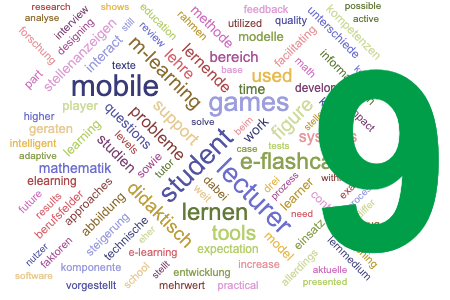
9. Issue July 2013
- Summary
- Issue 9 presents an investigation of barriers to a wider utilization of a Learning Management System in a Swedish university. Furthermore, an approach for enabling high-quality learning within oversized courses by e-flashcards, which enable active learning and individual facilitation within large-scale university courses, is presented. Finally, an overview on mobile learning from an educational perspective is presented.
- Zusammenfassung
- Ausgabe 9 präsentiert eine Untersuchung der Barrieren einer weitergehenden Nutzung eines LMS an einer schwedischen Universität. In einem weiteren Beitrag werden Erfahrung mit e-Flashcards vorgestellt: Sie sollen auch in überlaufenen Kursen die Qualität des Lernens steigern und aktives Lernen mit individueller Förderung ermöglichen. Schließlich wird ein Überblick über mobiles Lernen aus einer pädagogischen Perspektive gegeben.
Editorial
While adoption of e-learning is increasing, and new methods of improving the quality of e-learning are developed, the design of e-learning environments remains a complex task. Especially, when facing rapid technology development, such as in mobile and adaptive learning systems. In this issue, some interesting developments in the above areas are discussed:
Ramón Garrote investigates in his article barriers to a wider utilization of a Learning Management System in a Swedish university. He argues that the main barrier to a wider utilization of LMS is the lecturers’ fear of additional demands on their time, and that, in addition to support and training, incentives for lecturers are needed.
The issue of improving the quality of e-learning is in this issue addressed in three contributions: Inga Saatz and Andrea Kienle present in their article an approach for enabling high-quality learning within oversized courses by e-flashcards, which enable active learning and individual facilitation within large scale university courses. The project report by Meike Wocken presents a process management cycle to establish eLearning in university teaching. Using the project “eLearning QMM”, the practical approach of this management method is shown and costs and benefits are discussed. Finally, the book “E-Learning, E-Teaching und E-Assessment in der Hochschullehre” of Jürgen Handke and Anna Maria Schäfer is summarized, which presents a guideline for realizing quality and capacity improvements as well as reduction of efforts within a complex e-education system.
The design of e-learning environments is addressed in two dissertations and a project report: Christian Lehr presents in his dissertation “Web 2.0 in der universitären Lehre - Ein Handlungsrahmen für die Gestaltung technologiegestützter Lernszenarien” a framework for the design of technology-supported learning scenarios. Alfred Klampfer shows in his dissertation „E-Portfolios als Instrument zur Professionalisierung in der Lehrer- und Lehrerinnenausbildung“ how e-portfolios can be used to professionalize the education of teachers. Finally, the project report “A Simple Computer Game for Learning Mathematics” by Abejide Olu Ade-Ibijola, Adebayo Olusola Adetunmbi and Boniface Kayode Alese shows the design and implementation of a simple PC math game that teaches rudimentary topics in mathematics.
In the area of technology development, mobile learning and intelligent, adaptive systems are looked at close in this issue. In their article “Mobile Learning – Bringt das auch was?” Regina Parzl and Maria Bannert provide an overview on Mobile Learning from an educational perspective. It discusses terminology problems present in this interdisciplinary field, introduces relevant didactical models and theories, and presents a framework used to situate current research and to identify open issues. The book “Intelligent and Adaptive Educational-Learning Systems” of Alejandro Peña-Ayala is summarized, which deals in four parts with the modeling, presentation of content, use of virtual environments, and concrete applications of this type of system.
Regarding the competencies required by the German labour market, the project report on “IT-KompetenzBarometer” by Frank Bensberg and Daniel Vogel presents interesting results from an analysis of 40.000 job advertisements. The results can be used to better adapt education to the requirements of the labour market. The book „Visual Worlds & Interactive Spaces“ by Regina Franken-Wendelstorf, Elisabeth Lindinger, and Jürgen Sieck points to an interesting work offering deep insight in fundamental theories as well as in best practice applications of information, communication, interaction and visualization in virtual spaces within a specific cultural context. Finally, the project report on the CampusSource Congress at FernUniversität in Hagen on April 25th, 2013, makes available the contributions and presentations concerning Liferay, Lecture2Go, Hochschulapps, OERs-MOOCs, Open IDM, e-Identity, and the CampusSource White Paper Award.
Let me conclude this editorial with expressing my deepest gratitude to Bernd Krämer, who served as editor-in-chief from the beginning. I am glad, that Bernd continues to support eleed as a member of the editorial board. I am happy to announce that eleed will undergo a major renovation over the next two years regarding both, its user interface and appearance as well as the functionality provided to the community. We expect to make an improved web presence available in 2014, the 10th anniversary of eleed, and we hope to receive your feedback to better serve our readership.
Joerg M. Haake
Editor-in-Chief, eleed -
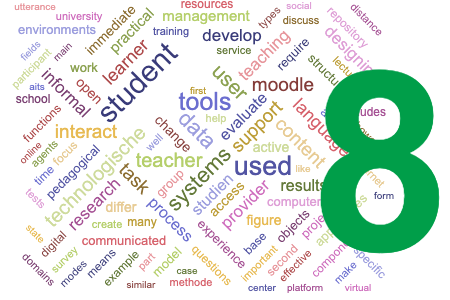
8. Issue June 2012
- Summary
- Issue 8 presents a survey on learning analytics, two articles on different environments for language learning, a longitudinal investigation of the use of an LMS at a Swedish university, and a feature that puts the learning paradigm in the context of Web 2.0 and discusses two specific aspects of this perspective: Darwikinism and Folksonomy.
- Zusammenfassung
- Ausgabe 8 präsentiert einen Überblick über Learning Analytics, zwei Beiträge über verschiedene Umgebungen zum Sprachlernen, eine Langzeitstudie über die Nutzung eines LMS an einer schwedischen Universität, und ein Feature, das Lernparadigmen in den Kontext des Web 2.0 stellt und zwei spezielle Aspekte dieser Perspektive diskutiert: Darwikinismus und Folksonomien.
Editorial
Recently I stumbled upon Dörte Giebel's review of e-learning trend predictions that are yearly published in a new Horizon report. She notes that game-based learning and augmented reality, although predicated to spread in 2010 and 2013, did not really lift off and the hype about open content and open educational resources did also not mature to a daily practice as assumed two or there years ago. I share Dörte's preference of mobile apps, tablet computing and learning analytics to be the most interesting trends among those forecast in the report, while it is difficult to judge possible impacts of gesture-based computing and the Internet of Things, which are sketched at the horizon of 4 or five years.
Apple seems to claim leadership in educational apps for mobile gadgets but most of these are aiming at kindergarten, k12, and general education but not much exists in higher education. Another approach pushed by this company is iBooks, which primarily target the open courseware community and exploit tablet-computing features of the iPad.
The constantly growing field of research and applications in learning analytics follows the example of (web) business analytics and uses a range of methods, including log file analysis, data and text mining, learner tracking and monitoring, process mining, and behavior analysis or social network analysis to obtain feedback on technical, pedagogical and social aspects of learning. Aspects of interest include: the learning effectiveness of certain e-learning tools or integrated tool environments, weaknesses and improvement potential in educational methods and content, learning styles, or group effects. A necessary prerequisite for learning analytics are mass data that can now be accumulated in virtual learning environments, learning management systems, and other learning tools.
A recent EDUCAUSE report entitled Analytics in Higher Education: Establishing a Common Language develops a unifying conceptual framework of the various types of analytics found in literature. A tech report of the British Knowledge Media Institute presents a review of the state of learning analytics in 2012. We strongly encourage readers who are or have been involved in leaning analytics projects to communicate their findings in the form of a project report or a scientific paper.
We are grateful to Erik Duval and Katrien Verbert for their survey article on "Learning Analytics", which provides a good start into this topic. Further this issue of eleed presents the usual mix of scientific articles, project reports, book reviews, and other community-related information. Ramón Garrote's paper about the use of learning management systems combines learning analytics and interview techniques. In the context of WebCT, the author compares usage data of communication and collaboration tools collected in 2004 and again 5 years later to understand possible changes in tool usage over the years.
The articles "Matching form with content" and "Language Learning in a 3D Virtual World" present two different environments for language learning. While the former aims at reducing the visibility of the underlying technology of the authors' computer-assisted environment, the latter employs Second Life (SL) - an online virtual world - for interactive language learning. In this new approach students do not attend a class in SL; instead, the learning experience is based on solving tasks by interacting with robotic agents.
Helen Crompton's paper about "How Web 2.0 is Changing the Way Students Learn" is more a feature than a research article. It puts the learning paradigm in the context of Web 2.0 and discusses two specific aspects of this perspective: Darwikinism and Folksonomy. Darwinkinism related Darwin's theory of evolution with processes typically observed in Wikis, while folksonomy adapts the idea of creating taxonomies on the fly as users collect and tag sources found in the Web. Helen picks on Prensky's construction of digital natives that is discussed controversially in Schulmeister's article about the "net generation" published earlier in this journal.
The project report about the use of Moodle presents the results of a survey among teachers on the use of this tool for face-to-face teaching in a Portuguese private higher education institution. Furthermore, we have four project reports on Probado, edu-sharing, DMG-Lib and OpenSC that grew out of a concluding workshop held earlier this year at the FernUniversität. All projects were funded for about 5 years by the German Science Foundation (DFG) under the umbrella theme "Centers of Excellence for Research Information - Digital Text and Data Centers for Science and Open Research" and are more or less related to e-learning.
Let me conclude this editorial with a personal matter: Having been in the editorial board since the very beginning, I am stepping back from the role of an editor-in-chief with this issue as my time with FernUniversität will come to an end soon. The editorial board is overly happy that Jörg Haake, an outstanding colleague at FernUniversität, agreed to take over. Jörg has been an active researcher in e-learning for 12 years. This year he is chairing DeLFi 2012, the annual e-learning conference of the German Computer Society. Jörg's original field of interest is computer-supported collaborative work and learning, with a focus on context-based adaptive collaborative learning environments and learning support for communities of practice. From the next issue on, you will hear more from him as the new editor-in-chief.
Bernd Krämer
Editor-in-Chief, eleed -
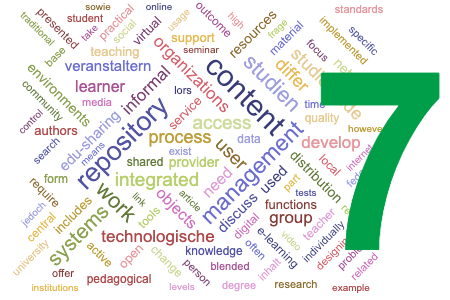
7. Issue July 2011
- Summary
- Issue 7 presents two articles on the state-of-the-art of educational digital repositories and learning (object) systems, touching particularly on the authors’ own distributed solution. The third article reports on three case studies performed in different Swedish public organizations investigating challenges and opportunities in reconciling work tasks and e-learning.
- Zusammenfassung
- Ausgabe 7 präsentiert zwei Beiträge über den Stand der Technik zu digitalen Bildungs-Repositorien und Lernobjekt-Systemen, die jeweils auf die spezielle Lösung der Autoren fokussieren. Der dritte Beitrag berichtet über drei Fallstudien aus verschiedenen schwedischen öffentlichen Organisationen, die jeweils die Herausforderungen und Chancen des Abgleichs von Arbeitsaufgaben und e-learning betrachten.
Dear readers,
we are happy to announce a new issue and the migration to a new server, which should substantially improve access speed to our online journal.
We have used the opportunity of migrating to a new server to update the site’s appearance, and introduce some editorial changes, including new services. In the headline you will recognize a new button “Authors”, which links to a list of all authors who ever contributed to this journal and their articles and reports. Further we renovated our RSS feed, which now allows you to decide whether you want to be informed about all contributions or you want to select individual categories only, like articles, project reports, and others. You may have noticed that the journal’s search functionality was sub-optimal in the past. The search function has been improved such that it delivers more exact matches and the advanced search now offers a range of possibilities to select specific search attributes. We have also added a tag cloud on the left, which gives you an instant view of the main topics addressed in the journal. Finally we have added a summary section in the lower part of each page. Besides a login, which is currently restricted to members of the editorial team, you can find a list of services, for example, for setting your feed or accessibility preferences, and you see a list of most recent contributions. More community services will follows as we find funds and competent software developers.
The contributions of this issue share the quality that they are all based on practical work and give particular attention to the interests of practitioners, both working in the field of instructional design and e-learning technology. Two of the three scientific articles describe the state-of-the-art in educational digital repositories and learning (object) systems in two parts, touching particularly on the authors’ own distributed solution. The first part aims primarily at readers who have a decent background in instructional design and are interested in the idea of sharing educational content and methodological knowledge but have a lesser interest in technological details. It focuses on information quality issues in the context of e-learning and provides some rationale for the technical approaches discussed in the second part. The second part addresses e-learning tool developers and offers a comprehensive survey of very different technologies.
The third article by Kerstin Grundén reports on three case studies investigating challenges and opportunities in reconciling work tasks and e-learning. The studies were performed in different Swedish public organizations. The paper reveals several factors that resulted in a low integration of learning outcomes and individual work processes and concludes with suggestions to overcome such deficits.
In this issue we have also included six project reports, two book descriptions, and four dissertation abstracts. Two of the project reports present blended learning approaches in economic departments, one describes empirical research on gender issues in the integration of IT at a Saudi Arabian university, and the forth contributes decision criteria that may guide the implementation of online lecture capturing and their distribution using different technologies. Two further reports summarize the content of two workshops on e-assessment and the introduction of identity management and smart cards in German universities. The dissertation thesis “The Effects of instructor-Avatar Immediacy in Second Life, an Immersive and Interactive 3D Virtual Environment” by Sabine Lawless-Reljic is remarkable because the thesis defense took place in Second World as well. Have a look at the linked in movie clips.
Bernd Krämer
Editor-in-Chief, eleed -
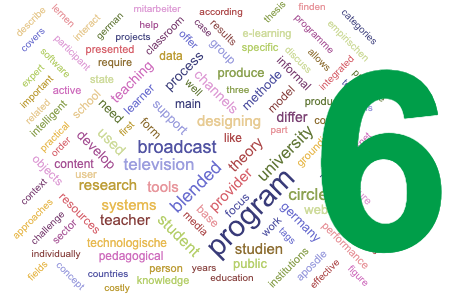
6. Issue July 2010
- Summary
- Issue 6 presents articles on educational television broadcasting in Germany, experiences with a website that both provides supplementary study materials and serves as a tool to perform empirical research with student involvement in the e-learning domain, determinants and challenges of the performance of blended learning in university teaching, and on the E-learning Circle, a holistic software design tool for e-learning.
- Zusammenfassung
- Ausgabe 6 präsentiert Beiträge über Bildungsfernsehen in Deutschland, über Erfahrungen mit einer Website, die sowohl zusätzliches Studienmaterial bereitstellt als auch zur empirischen Forschung über die Teilnahme der Studierenden dient, über die Determinanten und Herausforderungen der Performanz von blended Learning in der universitären Lehre, und über das holistische Software-Entwurfswerkzeug „E-learning Circle“ für e-learning.
Dear readers,
let me take this first issue in 2010 as an opportunity to celebrate the 5th anniversary of this journal. Without the commitment of many volunteers to help acquire outstanding contributions, review submissions, copyedit accepted papers, maintain the IT infrastructure and much more, the journal would not have made to the age of 5. We gratefully acknowledge their services. Three persons in the editorial team deserve special thanks here because they invest an exceptional amount of their time and do all this silently in the back-office: Manfred Postel, who is also responsible for the non-reviewed community contributions of each issue, our library specialist Martin Roos, who is the driver behind our information services, and Stefan Neveling, who copyedits each article and manages the underlying IT infrastructure.
This anniversary is also a good opportunity to thank two supporting institutions: the Ministry of Innovation, Science, Research and Technology of North Rhine-Westphalia, Germany, for the seed money that brought this journal to life and FernUniversität in Hagen, Germany, that provides financial support since the initial project funding ended. The latter was particularly important for the sustainability of our services because it is well known that viable business models for open access journals are difficult to find. The ones we confronted our users with like author-pays, reader-pays, and advertisement were not appreciated. Others like reader-sponsors-pay (e.g., university libraries) or author-sponsors-pay (e.g., foundations, research funding institutions, governments) are not easy to get. Even if such options are offered, as the Deutsche Forschungsgemeinschaft (DFG, German Research Foundation) does by asking funding recipients to publish their results primarily in open access repositories and by providing financial support for this, immediately a debate is raised that authors were bossed around and limited in their freedom to select a publisher of their choice. So, we are lucky that FernUniversität pays for all. Thank you.
Occasionally, long reaction times of the journal server may have annoyed some of you. This server, which is not maintained by us, publishes an increasing number of open access journal and seems to gradually reach its limits. The good news is that a new server has been established recently and some journals already migrated to that server. So the situation can only improve.
With the last issue we introduced a new community service in the form of a dissertation section, which provides key information about doctoral theses in the field of e-learning, including thesis candidate, reviewers, abstract and a link or reference to the full version of the thesis. As you can see from the current issue, this new section was well received and we are proud to present new findings of promising junior scientists.
During the last few months we have developed an open source literature database that serves to sustainably maintain bibliographic data of eleed-specific primary and secondary literature, i.e., all eleed articles and all bibliographic references in these articles, respectively. Based on this information we envision future community services and systematic evaluations, such as the extraction of citation networks, profiling of authors and institutes, or content-related ontologies. To begin with, the bibliographic data gathered would be exported and published on the eleed site as HTML pages, which can be sorted alphabetically by author names and title. A search function will be provided in the next development step.
To increase the usability of the literature database, we are highly interested in your feedback on services you like to see on top of it. We want to collect your feedback through a Wiki or forum. The URL for it will be soon arranged and published by eleed.
Again, we were able to collect a number of book and online publication descriptions and reviews, project reports, dissertation abstract, and, of course, peer-reviewed scientific papers and practice reports. The latter cover quite different topics ranging von educational TV to software design for e-learning.
Although in FernUniversität’s distance education system television broadcasting is not typical channel to convey study content to our students, educational television still plays a significant role in other contexts, in particular, at the school level. Misra’s paper entitled “Educational Television Broadcasting in Germany: Prevailing Practices, Existing Challenges and Adoptable Policies” investigates the current situation in Germany and reveals some potential for further improvement.
Running a website with supplementary material to a class-room or distance teaching course is nothing new and many of us offer it to our students. But only few of us spent deeper thoughts on methodological foundations and intended effects. In their German article “E-Learning-Webseite als facettenreiches Werkzeug in Forschung und Lehre“ Rey and Beck report on experiences with a website that both provides supplementary study materials and serves as a tool to perform empirical research with student involvement in the e-learning domain.
Until now, the added value of e-learning at campus universities has rarely been investigated systematically. Steffens and Reiss try to close this gap with their study “Performance of Blended Learning in University Teaching: Determinants and Challenges“. This work examines the advantages and disadvantages of blended learning based on the responses of 200 educators at polytechnics and universities in Germany and other countries.
In their article “The E-learning Circle - a holistic software design tool for e-learning” Kolås and Staupe introduce E-learning Circle as a tool to improve the quality of software design processes of e-learning systems. The research method, which relies on Grounded Theory, is described detailed enough to be adopted by others. Different types of uses of the circle model are discussed.
If you find this and earlier issues of eleed interesting and inspiring, please point it out to friends and colleagues who missed it so far.
Bernd Krämer
Editor-in-Chief, eleed -
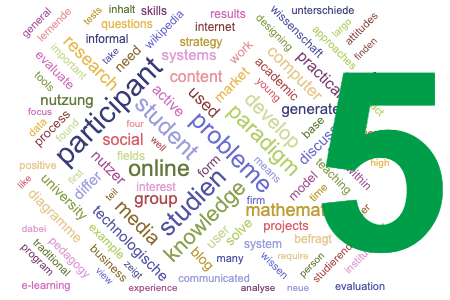
5. Issue July 2009
- Summary
- Issue 5 presents Schulmeister’s article on whether a net generation really exists. Pinkwart et al. present an adaptive tutoring system for law students to acquire argumentation skills. Koch et al. report about an online survey on the use of Web 2.0 tools in science. Duus presents a socioeconomic approach for the development of e-learning. Finally, Kian-Sam Hong et al. analyze an online mathematical problem solving course for teachers in Malaysia.
- Zusammenfassung
- Ausgabe 5 beginnt mit Schulmeister’s Beitrag über die Existenz einer „Net Generation“. Pinkwart u.a. stellen ein adaptives tutorielles System für die Argumentationsfähigkeit von Jura-Studenten vor. Im dritten Beitrag präsentieren Koch u.a. Ergebnisse einer online Befragung zur Nutzung von Web 2.0 Tools in der Wissenschaft. Duus stellt einen sozio-ökonomischen Ansatz für die Entwicklung von e-Learning vor. Abschließend analysieren Hong u. a. einen online-Kurs zum mathematischen Problemlösen für Lehrer in Malaysia.
Some thought about the evolution of e-learning
More and more of us live in two worlds: the physical and digital world. In the physical world we are embedded in traditional social communities (Gemeinschaften) that rely on local proximity, strong reciprocal bonds of kinship, reliance, obligation and mutual benefit (Tönnies 1887). Internet-based social networks, platforms and communities are complementing this concept and they are partly changing its meaning. In the digital world the significance of physical location takes a second place to symbolic interaction processes in which competences and the reciprocal negotiation of trust relationships takes a leading role. Thus, “the traditional character of communities linking people in places and establishing real, organic and sustainable connections between them is widened to linking people wherever they are” (Welman 2001). This offers new options to the members of a social network. For example, Mark Granovetter (1973) emphasizes “the strength of weak ties”. What he means by this is the observation that members of a social community with close interpersonal relationships (strong ties) are often less helpful in the solution of one’s specific problem than those to which only weak ties exist but who are more competent in the solution space. He provided empirical evidence for this hypothesis for the problem of job search. Followers have tested this hypothesis on other problems as well.
In the physical world we acquire value, skills and knowledge from people in our environment, in classrooms, lecture halls, laboratories or hospitals, and from physical resources like books, journals, from equipment and tangible instruments. In the digital world we are confronted with a drastically increasing amount of information sources, with virtual environments, virtual realities, even virtual worlds like second life. Also in science the digital world becomes indispensible with its potential to make research information of all kinds accessible over the Internet. Open access movements around the globe try to overcome the print-on-paper age with expensive – for many institutions and countries unaffordable – subscription models. They benefit individual researchers with increased visibility, use and impact of their work but also the society at large with enhanced access to research findings and educational materials.
Web 2.0 with its participatory and interactive media and the Semantic Web are providing further dimensions to the digital world that need to be explored. All this has a tremendous impact on learning and education that is far from understood, both advantages and risks. The growing amount of online resources, for instance, offers ample opportunities for smoothly combining informal and formal learning experiences. If the online resources are, in addition, decorated with machine-readable semantic data, options exist to generate individualized learning paths automatically (see, e.g., http://didaskon.corrib.org/). The contributions of this issue shed some light in different corners of this largely unexplored research space.
The articles of this issue
In his article entitled “Is There a Net Gener in the House?“ Rolf Schulmeister, a pioneer in e-learning, critically investigates the question whether a net generation really exists, in the sense that its members learn differently than earlier generations and exhibit further common attributes that distinguish them from other generations. Schulmeister presents his conclusions of a decent analysis of a range of empirical studies published in books and scientific articles of professional authors like Prensky, Tapscott, Oblinger & Oblinger and others. He critically investigates the authors’ claims and analysis methods and argues for subtle differentiation of observations made and classifications derived from them.
Pinkwart, Aleven, Ashley, and Lynch introduce an adaptive tutoring system aimed to help law students in acquiring argumentation skills and practice strategies in structuring the proper flow of arguments and counter-arguments in legal texts like opinions and protocols. Their tool imposes a diagrammatic representation of such structures upon legal texts. In the construction of feedback to student actions the tool designers had to find special solutions as – other than in natural and engineering sciences - the subject domain is not well structured and the solution space does not offer a unique or best solution.
The article “Onlinestudie: Wissenschaftliches Arbeiten im Web 2.0“ (in German) presents and discusses the findings of an online survey on the use of Web 2.0 tools in science. The authors evaluate the potential of such tools and address possible negative impacts of their use on scientific practices. The survey was conducted in a research project investigating the character of scientific work in Web 2.0 from different angles. In section “Project Presentations”, the first author of this article sketches another outcome of this project: a Web 2.0 type of software supporting academic writing, scholarz.net.
A “Socioeconomic Approach to the Development of E-Learning” is adopted by Henrik Johannsen Duus. Starting with a summary of previous attempts to classify different types of e-learning, the author criticizes pedagogical, technological, or organizational categories used in earlier studies and reveals methodological weaknesses of these analyses. Using economic, sociological, and marketing theories as the basis for distinguishing characteristics, he initially suggest the separation of e-learning industries in two categories, knowledge transfer and knowledge creation. Duus then refines the classification by adding two new dimensions: “Business orientation vs. academic orientation” and “learning orientation vs. teaching orientation”. This leads to a separation into four e-learning paradigms: the technological, content-based, pedagogical, and the market-based paradigm.
The last article in this issue presents the analysis of an online mathematical problem solving course for teachers in the second semester of a Graduate Diploma Program at the Batu Linfang Teachers’ Institute in Sarawak, Malaysia. The authors partly replicate previous findings but add a novel perspective by training mathematical problem solving based on Polya's method. They use quantitative and qualitative methods (questionnaires and interviews, respectively) to measure the students' satisfaction, the improvement of their skills and the impact on demographic characteristics.
Project Presentations
Besides the report on scholarz.net, this section introduces a virtual teaching assistant that was developed in the VITA project and has been implemented as an extension to the course authoring and learning management system LON-CAPA. The assistant supports instant correctness checking and grading of homework assignments and it offers a peer-teaching feature for students to help each other solving the assignments.
The “ambient computing education” project aims to advance student mobility across the Atlantic with pilot student exchanges, the provision of a contemporary curriculum addressing society’s growing need for transdisciplinary knowledge and skills, and a technical infrastructure including Web 2.0 services, social networking features and access to online knowledge resources.
The third report “Leveraging Informality within eLearning” particularly addresses the skills and competences of “Schulmeister’s net generation” in mastering computers, in general, and Web 2.0 tools, in particular. It sketches a project that aims to integrate informal and formal learning opportunities by extending contemporary learning content players with facilities to include and share informal learning content, ratings and recommendations.
Dissertations
Frequent readers of our journal may have noticed that we have introduced a new category in the community section: Dissertations. Here we present abstracts of PhD dissertations that address e-learning problems. Dissertations that have been published online, are directly linked on the abstract page. We welcome submissions of dissertation abstracts and references to the published work in whatever language. Abstracts in English are, however, preferred.
References
Granovetter, Mark S.: The Strength of Weak Ties. In: American Journal of Sociology, Vol. 78, 1973, issue 6 , pp. 1360-1380
Tönnies, Ferdinand: Gemeinschaft und Gesellschaft. Wissenschaftliche Buchgesellschaft, Darmstadt, 1887. (in German, first print 1887, reprint 1935)
Wellman, Barry: Physical Place and CyberPlace. In: International Journal of Urban and Regional Research, Vol. 25, 2001
Bernd Krämer
-
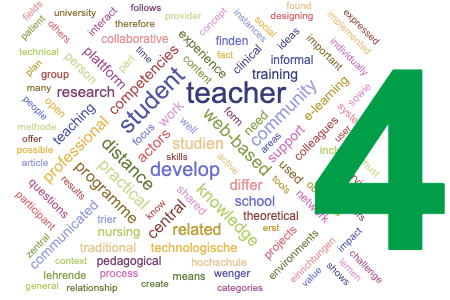
4. Issue July 2008
- Summary
- Issue 4 begins with an article on teachers who are involved in web-based learning applications in schools and who form a community of practice. Another article presents a comparative study of two traditional nursing schools and a distance learning program. The third article investigates infrastructural and strategic issues related to the organizational embodiment and sustainably effective use of learning management systems in universities.
- Zusammenfassung
- Ausgabe 4 beginnt mit einem Beitrag über das Verhalten von Lehrern, die in Web-basierte Lernanwendungen an Schulen eingebunden sind, und die eine Community of Practice bilden. Es folgt eine vergleichende Studie an zwei traditionellen Krankenpflege-Schulen sowie einem Fernlehr-Programm. Der letzte Beitrag behandelt Strategien für die organisatorische Verankerung von Evaluations- und Re-Evaluationsprozessen an der Universität Trier.
Editorial
Recently, in a project review meeting I heard a reviewer saying: “e-learning is no research topic anymore. We should not fund the e-learning component of this project.” I was puzzled. Maybe he was right – at least if we reduce the concept e-learning to the provision of digital learning content and digital technologies supporting the learning processes. Online learning (Anderson & Elloumi, 2004) has entered the mainstream (The Sloan Consortium, 2004). The e-learning industry expands continuously, competing with well-received educational open source products. Lots of learning management platforms have been built and used; e-learning scenarios and software tools supporting content authoring, learning path and activity design, communication, collaboration and group work, testing and assessment, portfolio management, and other e-educational activities became commodities; these developments are backed up by e-learning standards aiming at the interoperability of tools and applications, the portability of content and educational scenarios from platform to platform, and the compatibility of cross-system and cross-institution workflows. Many (higher) educational institutions have already defined their strategy and implementation plan for developing and embedding e-learning or are already using it in their daily practice.
If this were the end of the story, we could close our journal or – at least - the scientific paper section. But luckily there is a growing awareness among researchers, practitioners and organisations that a mere technology-focussed approach does not guarantee better teaching and learning experiences. Education theorists like Benjamin Bloom, Burrhus F. Skinner, and many others devoted much of their life to understand the possibilities and psychology of education, human behaviour and the growth of knowledge. As they lived at a different time and as I believe that opportunities create new intentions and actions, some of their findings need to be and are reconsidered in the context of e-learning.
The whole field of educational technology aims to transform educational and psychological theories into meaningful pedagogical practices. It also tries to provide qualitative and quantitative evidence that the use of digital technology and novel pedagogical approaches like web pedagogy, online learning, or personalised and adaptive learning affects educational processes positively. My impression is education technologists are highly sought and are facing challenges that provide plenty of work for the future. Technology-wise usability is far from perfect, and ongoing developments in the Internet like Web 2.0 and higher are creating further changes. Large deficits still exist in our understanding of knowledge and experience sharing processes and mechanisms and the role of web communities in educational contexts.
So we can be in good hope for future high quality submissions addressing, e.g., technological novelties, innovative educational scenarios, or commoditised content production methods, always in combination with evidence demonstrating a pedagogical or otherwise manifested added value.
The articles of this issue support these observations. But before I briefly get to the scientific contributions of this issue, I wanted to respond to a question, we are frequently asked: „Is it possible to edit a special issue with scientific papers on a particular topic?“ Our answer is: Yes! Propose a topic, describe how you plan to acquire and select high quality contributions, and suggest a tentative publication date. We will discuss your suggestion with the editorial board members and give you a qualified feedback.
The paper by Ryymin, Lallimo and Hakkarainen presents the findings of empirical research work that tried to understand the behaviour of teachers who are involved in web-based learning applications in schools and who form a community of practice whose aim is to share professional experience and evolve its members’ proficiency in that field. Social network analysis, interviews and phenomenographic methods were used as tools in this research, where the latter is a qualitative approach to determine how individuals constitute the meaning of a phenomenon. Both the combination of research methods applied and the findings, which have a potential to carry over to other communities of practice, make the paper valuable to read.
Starting point of the paper by Fredskild are the potential deficits of the distance teaching model in nursing education in which the interaction between peer and apprentice is a basic mechanism of the learning process, especially during clinical training. The author presents the results of a comparative study of two traditional nursing schools and a distance learning programme. The study examines differences and similarities in skills and competences acquired, differences between the programmes, and differences in types of students attracted. In conclusion the authors suggests some guidelines to the teaching design in distance programmes.
The third article (in German) by Jäckel, Leuenhagen and Röpke addresses infrastructural and strategic issues related to the organisational embodiment and sustainably effective use of learning management systems in universities. The stepwise process adopted by the University of Trier with the components: organisational structure, LMS evaluation, selection criteria, recommendation, and regular re-evaluation are presented in detail together with a range of lessons learned.
Bernd Krämer
-
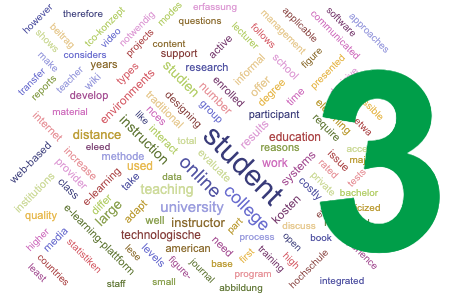
3. Issue July 2007
- Summary
- Issue 3 presents two articles on e-learning in the US: Firstly, Schulmeister critically reflects on the suitability of e-learning in the US as a global standard or benchmark. Secondly, Ellis presents a framework for adapting a large, residential course to the Web. In addition, Bensberg, Grob, and vom Brocke present the Total Cost of Ownership-method (TCO-method) to cast light on the cost-effects of e-learning platforms.
- Zusammenfassung
- Ausgabe 3 präsentiert zwei Beiträge zu e-Learning in den USA: (1) Schulmeister reflektiert kritisch die Eignung des e-Learning in den USA als globaler Standard oder Benchmark. (2) stellt Ellis ein Framework für die Übertragung eines großen on-Campus-Kurses auf das Web vor. Daneben präsentieren Bensberg, Grob, und vom Brocke die Total Cost of Ownership-Methode um Kostenfaktoren von e-Learning-Plattformen zu beleuchten.
Editorial
Well, it has been a long time since the last issue. We are way beyond of having a regularly issue at least twice a year. We even got emails like “does eleed still exists?”—Yes, we are still alive! And we are happy to present an interesting third issue to our beloved readers. As you are now aware, we now make accepted articles visible in the “preview” area of the journal prior to "binding" the next issue. Moreover, we tried to reduce the amount of time that passes between when an author submits an article until the final decision. However, the bottleneck towards improved time-to-market is still our review process. As highly qualified experts, our reviewers are overly busy and just need enough time to prepare a well founded review. And yes, they are doing a great job and it is time to say a big THANK YOU to our large group of reviewers. They are the insurance for the high quality we want to achieve. If the acceptance rate is an indicator for quality, then we achieved this goal: From 60 submissions to the refereed section, we have only accepted 12 for publications—that is a 20% acceptance rate.
As you may have noticed, we had published a questionnaire for our readers last year. Meanwhile, we have evaluated the answers and we do no longer want to withhold the results from our readers. The evaluation of the feedback confirms that we achieved our goal concerning the concept, the design, and the content of our open access journal. This is important in instable times where new open access journals emerge every month, while other open access journals in our area cease to exist, for example IMEJ, the Interactive Multimedia Electronic Journal of Computer-Enhanced Learning is no longer published.
In the scientific section, we have three interesting contributions in this issue: In “eLearning in the USA: The Standard? The Benchmark?“, Rolf Schulmeister presents some critical remarks on e-learning in the US as a contribution to the current discussion in Europe. In particular, he wants to initiate a discussion about the question whether the European study system is in danger to imitate the shortcomings and consequences of the American educational system. Although our publishing platform currently does not support discussions or blogs related to articles, we are very much interested in your comments if you feel inspired by Rolf Schulmeister’s thoughts. Please send any feedback to eleed@campussource.de — of course, we are interested in any feedback, not only to this particular article.
Complementing Rolf Schulmeister’s article, we have an article from Maureen Ellis presenting some practical experiences on e-learning in the US: In “Changing the Face of Traditional Education: A Framework for Adapting a Large, Residential Course to the Web”, she identifies and discusses instructional design theory for making a large, lecture-based course ready for Web-based learning.
For the German speaking readership, Bensberg, Grob, and vom Brocke present the Total Cost of Ownership-method (TCO-method) to cast light on the cost-effects of e-learning platforms. Their article will probably make it possible to measure if the use of e-learning at universities can really reduce the costs of educating increasing numbers of students.
In the project report section, we have four contributions: Andreas Bethmann and Marco Bohnsack present results of a project called “Efficient Management of Wastewater, its Treatment and Reuse in the Mediterranean Countries (EMWater)” within the article “Stud.IP and ILIAS in an EU-Funded Project for the Middle East”. Web Based Training (WBT) is used with the aim for refreshing the knowledge of wastewater experts in the Mediterranean Countries and promoting cross border knowledge transfer. In “E-Learning 2.0 in hydraulic engineering education”, Stefan Walder and Wolfgang Hagleiter report about the results of an online collaboration with the usage of Wikis.
In the German speaking section, Frank Bensberg complements his article about the Total Costs of Ownership (TCO) with a report on the Total Cost of Services (TCS) of Learning Management Systems. He refers to the ITIL Reference Model to point out methods determining cost factors of the usage of e-learning platforms. Olaf A. Schulte reports of his experiences with distance education in Australia: His report “2000 kilometers each day” (“2000 Kilometer am Tag”) focuses on video conferencing and describes how e-learning reaches the far-flung regions of the country.
This time, we have five reviews of interesting books in our book review. Their content can be divided into three subjects: First, we have two books about security for e-learning, online-courses, and online platforms. The first book on this subject is “Security in E-Learning”, written by Edgar Weippl, and addresses researchers as well as IT professionals. The second one, “Impacts and Risk Assessment of Technology for Internet Security Enabled Information Small-Medium Enterprises (TEISMES)” written by Charles A. Shoniregun, is not only interesting for researchers and practitioners in the area of e-learning, but also more generally for online platforms and online shops.
The second subject addresses people in education and how to build successful courses in a didactic way. “Lessons in learning, e-learning, and training – perspectives and guidance for the enlightened trainer” by Roger C. Schank shows this in a very personally way. “Efficiency in learning – evidence-based guidelines to manage cognitive load” by Ruth Colvin Clark, Frank Nguyen, and John Sweller contains some theoretical aspects in education and teaching.
The last subject shows the implementation of e-learning in a very special field. “E-Learning in Process and Chemical Engineering – A Practical Overview” by Günter Wozny complements the subjects above in a practical implementation.
We hope that you find this issue of eleed as interesting as we do. Have fun reading it and don't hesitate to give us your feedback!
Jens Krinke
Bernd Krämer
Manfred Postel
Martin Roos -
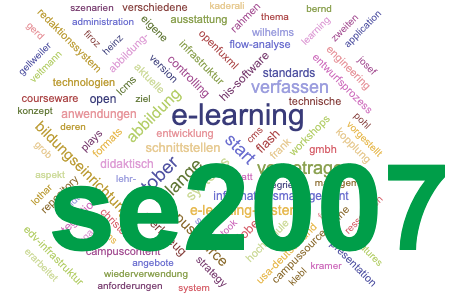
Sonderausgabe 2007
- Summary
- The special edition presents the results of the CampusSource Workshop 2006 on integrated information management for educational organizations. Main issues of the conference were the development of an e-learning engine to connect e-learning applications with the administration systems of the HIS GmbH (ltd), and the creation of reusable learning content.
- Zusammenfassung
- Die Spezialausgabe präsentiert die Ergebnisse des CampusSource Workshops zu integriertem Informationsmanagement für Bildungseinrichtungen. Kernpunkte der Veranstaltung waren die Entwicklung einer Engine zur Verknüpfung von e-Learning Anwendungen mit Systemen der HIS GmbH und die Erstellung von wiederverwendbaren Lehr- und Lerninhalten.
e-learning and education (eleed) Sonderausgabe zum CampusSource Workshop 2006
Hinweis zur Wiedergabe der Vorträge
Die nachfolgend gelisteten Videos liegen im nicht mehr supporteten Flash-Format vor. Für Wiedergabe ist daher ein sogenannter Flash Player Emulator wie "ruffle - An open source Flash Player emulator" erforderlich.Die Vorträge:
- Flowanalyse von Open Source-Entwicklungen
Heinz Lothar Grob - Integriertes Informationsmanagement für Bildungseinrichtungen - CampusSource Ansätze und Ausblick
Firoz Kaderali - e-Learning in Bildungseinrichtungen – Anforderungen, Rahmenbedingungen, IT-Infrastruktur
Josef Hüvelmeyer - Szenarien und Technologien zur Integration von e-Learning in bestehenden Infrastrukturen - Das Projekt CampusSourceEngine
Christof Veltmann - CampusSourceEngine - Die CSE Integration Platform
Christof Pohl - Schnittstellen von e-Learning Anwendungen zu Dokumenten- und Publikationsservern
Frank Lützenkirchen, Marcel Heusinger - Schnittstellen von E-Learning Anwendungen mit Systemen der Hochschulverwaltung
Christian Arndt - Open Source e-Learning-Projekte und Strategien - USA / Deutschland im Vergleich
Gerd Kortemeyer - Die aktuelle Strategie zur Weiterentwicklung der HIS-Software
Uwe Hübner - Controlling von e-Learning-Systemen - Konzepte, Methoden und Werkzeuge
Frank Bensberg - Zum Umgang mit Lernobjekten - Technische und didaktische Aspekte bei CampusContent
Bernd Krämer - openFuXML - Ein Cross-Media-Publishing System
Jan Gellweiler, Stefan Gebhard - Standards, Werkzeuge und Repositorien im didaktisch-methodischen Entwurfsprozess: Skizzen zu Anforderungen und künftigen Entwicklungen
Michael Klebl
-
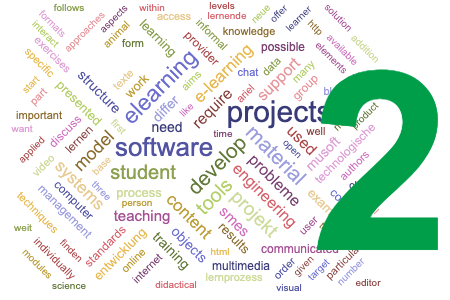
2. Issue December 2005
- Summary
- Issue 2 presents two articles on teaching software engineering (SE): the MuSoft portal offering 250 free learning objects for SE, and the description of the didactical setup, content creation, and experiences in an e-learning course on SE. Two more articles present a reference model on learning content systems with a multi-channel strategy and a report on the chances and perspectives of various European e-learning projects for SMEs.
- Zusammenfassung
- Ausgabe 2 präsentiert zwei Beiträge aus dem Bereich des e-Learnings im Software Engineering (SE): (1) das MuSoft Portal mit 250 freien SE-Lernobjekten und (2) die Beschreibung des didaktischen Designs, der Inhaltserzeugung und der Erfahrungen in einem e-Learning-Kurs zu SE. In zwei weiteren Beiträgen wird ein Referenzmodell für Learning Content-Systeme mit einer multi-Kanal Strategie vorgestellt und über Chancen und Perspektiven europäischer e-Learning-Projekte für KMUs berichtet.
Editorial
We are happy to present the second issue of the "e-learning and education" journal. Producing an electronic open access journal is a very interesting and challenging task--we are in the middle of the ongoing discussion on open access. There are two important reasons: First, open access articles have significantly higher citation impact than non-open access articles. Second, open access is a way out of the libraries' journal budget crisis. Many people are talking about the "golden road" and the "green road" of open access. The green road is basically self-archiving of traditional publications by the authors. The majority of journals allow self-archiving and many authors already "archive" their articles either on their web page or in a dedicated repository. However, the potential readers still have to find these articles.
We are on the "golden road" by actively promoting an open access journal. Our journal is free for all and the long term accessibility is ensured; no articles will "vanish" because an author moves or removes his web pages.
More interesting are the challenges and possibilities of electronic publication. Weber-Wulff and Schmiedecke's article "Learning Software Engineering via Internet" has (embedded) additional material: a flash animation, a chat recording, and a movie. This makes the article an interesting experience and would have not been possible within a traditional, paper-based article. Similarly, "eLearning--a chance for small and medium sized enterprises" by Hamburg, Lindecke, and Terstriep also contains a flash animation. We hope that future articles will also use such possibilities for the benefit of the reader.
As you might have noticed, we have changed the mode of publication: There are still issues that are published regularly. However, the final versions of accepted research papers are now published as "previews" to achieve a timely publication. They are already citeable and their URL and URN stay the same when they appear in the next issue of eleed.
We have some exciting future plans for eleed and one of the next things will be the possibility to download articles in pdf format.
Again, this issue consists of three parts: reviewed e-learning articles, non-reviewed project reports, and e-learning book descriptions. In the first part, there are four interesting articles. Two of the articles complement each other--they both focus on teaching software engineering via e-learning.
In "Software Engineering and eLearning: The MuSoft Project" Doberkat et al present their experiences with e-learning specifically dedicated at teaching software engineering. Like any other engineering discipline, software engineering is not very well suited for teaching in a classical way. Doberkat et al present the project MuSoft, which enhances software engineering courses with videos, animations, and dedicated tools. The project's results include a portal which offers more than 250 different free learning objects in the field of software engineering.
While Doberkat et al focused on the learning objects, Weber-Wulff and Schmiedecke report about the experiences with a complete e-learning course for software engineering in "Learning Software Engineering via Internet". Besides discussion about content creation and didactical setup, they focus on experiences with online teamwork and communication training.
The article "Multi-Channel-Learning" from vom Brocke (which is only available in German) focuses on learning content systems with in a multi channel strategy. Such a strategy is necessary to adapt to the varying learner's context and preferences. Vom Brocke presents a reference model which has been implemented in two e-learning platforms (Freestyle Learning and OpenUSS) and reports on experiences.
The fourth paper, "eLearning--a chance for small and medium sized enterprises" by Hamburg, Lindecke, and Terstriep, reports on the chances and perspectives of the various European e-learning projects for small and medium sized enterprises (SMEs). It contains three examples of such European projects and reports on the state of the art in the European countries.
Besides the four scientific articles, this issue includes four non-reviewed project reports about e-learning in public administration, an authoring tool for XML content management, courseware for Bayesian decision making, and e-learning for the handicapped.
Also, we have included four reviews of interesting German books in the area of e-learning.
We hope that issue is at least as interesting as the first. Have fun reading it!
Jens Krinke
Co-Editor-in-Chief, eleed -

1. Issue February 2005
- Summary
- Issue 1 presents frameworks for design of technology supporting a certain pedagogical approach, the open source LMS Stud.IP, the use of log file analysis to analyze frequencies, foci, occasions and patterns of use and compare them to intended didactical purposes, the FuXML authoring system for creating content in media-neutral form, and the use of model driven architecture to create e-learning components based on platform independent models.
- Zusammenfassung
- Ausgabe 1 präsentiert Frameworks für pädagogisches Technologiedesign, das open source LMS Stud.IP, die Nutzung von Logfile-Analysen zum Vergleich von Nutzungsweisen und intendierten didaktischen Zielen, das FuXML-Autorensystem zur medienneutralen Erzeugung von Inhalten, sowie die Nutzung modellgetriebener Architekturen zur Erzeugung plattformunabhängiger e-learning Komponenten.
Editorial
In 2003, Joseph Weizenbaum in his article Grenzen des E-Learnings (Limits of e-learning), sarcastically remarked that “the prefix e in e-learning may stand for the state of euphoria the topic is currently looked at” – once again, I would like to add. Technology and, in particular, computers in education have been an issue for more than thirty years. Progress and encouragement in this field have not been along a straight path but rather have seen euphoric ups and depressed lows. These waves were in parts caused by technological pushes initiated, for instance, by black-and white video films (1975), Papert’s turtle graphics (1980s), pixel graphics (1985), hypertext, CD-ROM, hypermedia, and, finally, the Internet. But most of the educational innovations that built on these technologies, including TV in schools, computer aided instruction, computer-based training and many more, finally ended up on the cemetery of educational technology.
Typical misconceptions about technology supported education, which led to the failure of these attempts, assumed that it can replace traditional in-class teaching, that it would help governments in finding arguments to cut down the costs of education, and that the interactive acquisition of learning content distributed as “canned” information would be sufficient to improve the quality of learning. As we began to surf on the most recent technology wave, the World Wide Web (WWW), which offered an extension of the hypertext idea but now with on-line, world-wide interconnection within the Internet and a seamless integration of multiple types of media, many of us were again caught by the same misconceptions as we focused too much on technology and neglected pedagogy and the human factor in education.
As the e-learning hype of 2000 is somewhat muted and more realistic, we observe e-learning applications settling in educational institutions at a large scale, in organizations and in corporations all over the world. The mostly IT-literate group of early adopters is now joined by specialists from many different scientific disciplines who want to share their experiences and learn from each other.
The open access journal eleed – e-learning and education – aims to provide a forum for researchers and practitioners active in the field of e-learning and become a focal point for the exchange of high quality scientific research results and experience reports addressing all aspects of e-learning theory, practice and technology. In addition, eleed supports cooperation and community building and fosters the evolution of open e-learning standards. The journal strives to maintain an international balance by relying on experts from all corners of the world.
eleed is a peer-reviewed archival online journal with a quarterly publication cycle. Besides peer-reviewed research papers, survey articles, case studies, and best practice reports, each eleed issue will include non-reviewed short contributions. Examples are: project descriptions, book, product and standards reviews, position statements, and discussion threads.
This inaugural issue of eleed consists of five scientific contributions, covering a broad range of topics, but mainly related to e-learning platforms, solutions, and technology. In “Pedagogical quality in e-learning - Designing e-learning from a learning theoretical approach” Christian Dalsgaard argues that evaluation and design of e-learning technology must be grounded in a learning theoretical approach because e-learning technology is not pedagogically neutral. Thus, it is necessary to focus on the design of technology that explicitly supports a certain pedagogical approach. His article presents three frameworks developed on the basis of cognitivism, radical constructivism and activity theory.
On the other side of the spectrum, Stockmann and Berg present a concrete e-learning platform in their article “Stud.IP – Ein Informations- und Managementsystem zur Unterstützung von Lehre und Studium” (an English version will be available shortly). This open source platform is dedicated to support traditional in-class education at universities but does not try to replace them. This article presents the rationale underlying their design decisions, explains how the platform is used in different scenarios, and presents an evaluation of Stud.IP.
How the students' use of an e-learning platform can be monitored and evaluated is the topic of “Matching Software and Context in Open Learning Scenarios” by Pape, Janneck, and Klein. They rely on log file analysis to investigate whether the way CSCL applications are used corresponds to the intended didactical purposes. Based on a concrete course performed in the form of an open learning scenario in which the CommSy CSCL system was used, the authors present their technique of using log files to analyze frequencies, foci, occasions and patterns of use and compare them according to different user types and groups. Their evaluation showed that in spite of students’ former negative experiences with teamwork and some insecurity at the beginning of the course participants produced high-quality working results and rated open learning scenarios positively.
In distant teaching scenarios, traditional, text-book like course materials are often still the most important media. In their article “Developing and Deploying an XML-based Learning Content Management System at the FernUniversität in Hagen”, Steinkamp et al. present FuXML, an authoring system that enables content creation in a media-neutral form from which several different presentation formats can be generated through specialized transformation processes. The authors describe the economic reasons, the environment, and the technical realization of the system, which is aimed to provide a practical and efficient solution for authoring, maintenance, production, and distribution of online and offline distance learning materials.
The last article, “Model Driven Architecture (MDA): Integration and Model Reuse for Open Source eLearning Platforms” by Grob et al., argues that integration activities are needed for open source e-learning platforms because most of the often similar projects possess small financial and human resources. They propose to use Model Driven Architecture (MDA), which is currently a research topic in software engineering, to capture functionalities and to identify similarities between available open source e-learning platforms. Based on the OpenUSS learning management system, they exemplary present a first milestone to create e-learning components based on platform independent models.
The scientific articles are complemented by four project reports: About the design and implementation of a collaborative problem-based learning environment called Smash, a European marketplace for e-learning offerings, a survey on European e-learning projects targeted at small and medium sized enterprises and last but not least about CampusContent, a competence center for e-learning with reusable learning objects.
For the German speaking reader, four interesting books are presented providing hands-on learning and e-learning experience, a handbook for e-learning, quality in e-learning from the view of the learner, and a study about successful web-based learning.
We hope that you find this first issue of eleed as interesting as we do. Have fun reading it!
Acknowledgments
We wish to thank all future readers, authors, and reviewers for their contributions to make eleed an exciting, high-quality journal in the field of e-learning and e-education. As a reaction to our first call for contributions issued in autumn 2004, we received 16 submissions of which five were selected for this issue. We are particularly grateful to the authors of these papers and more than 30 international experts who help us in the review process. Further we are deeply indebted to the many people who worked behind the scenes and the Ministerium für Wissenschaft und Forschung NRW (Department of Science and Research of the State Government of North Rhine-Westphalia), which financially supports our journal through its open access initiative “Digital Peer Publishing NRW”.
Bernd Krämer
Jens Krinke
Co-Editors-in-Chief, eleed

